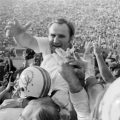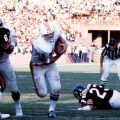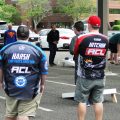Tag Archives: jerseyman articles

The Power of Fun – Dave Raymond, The Original Phillie Phanatic

The Phillie Phanatic is the greatest mascot in sports…largely because original Phanatic Dave Raymond simply put on the costume, went out and had fun. I had a chance interviewed Dave, who now creates team mascots as the owner of Raymond Entertainment Group, for the April 2015 issue of JerseyMan. You can view the PDF of the magazine article here.

Dave Raymond, the original Phillie Phanatic, with his best friend. (photo courtesy of Dave Raymond)
The Power of Fun
Imagine being a business owner who is looking to improve your marketing. You want a smart, polished, exciting campaign to bring life into your adequate but unmemorable image. You want to target a younger audience that otherwise might not discover your product.
Needless to say, this problem requires professional expertise, so you call in a consultant.
A consultant who, for much of his adult life, made his living wearing a furry green costume, recklessly riding around in an ATV and thrusting his ample hips at sports officials.
Because if your company is a minor league baseball team, and the idea is to bring more kids to the ballpark, and you want to create a mascot on that basis, hiring the original Phillie Phanatic to handle the design is a no-brainer.
As the man behind arguably the most beloved mascot in sports, who today is the “Emperor of Fun” at Raymond Entertainment Group, Dave Raymond understands the marketing value of a fun diversion.
Even if he learned it by accident.
“The joke was that the Phillies got the kid that was stupid enough to say yes,” Raymond says with a laugh. “I was a student at the University of Delaware. I had my fraternity brothers telling me, ‘they’re gonna kill you, they’re gonna hang you in effigy and set you on fire, and that’s when the Phillies win! When they lose you’re really gonna get in trouble!’
“That first day, I went into Bill Giles’s office and said, ‘Mr. Giles, what do you want me to do?’ A smile came across his face and he said, ‘I want you to have fun.’ I was tearing out of his office thinking, ‘Wow, this is going to be easy,’ and he screamed, ‘G-rated fun!’
“The first night I fell over a railing by accident, and people laughed. So I was thinking, I have to fall down more. Slapstick humor was something I loved, I was a Three Stooges fan, I watched all the cartoons. It was Daffy Duck and Foghorn Leghorn and Three Stooges because that’s what they laughed about.”
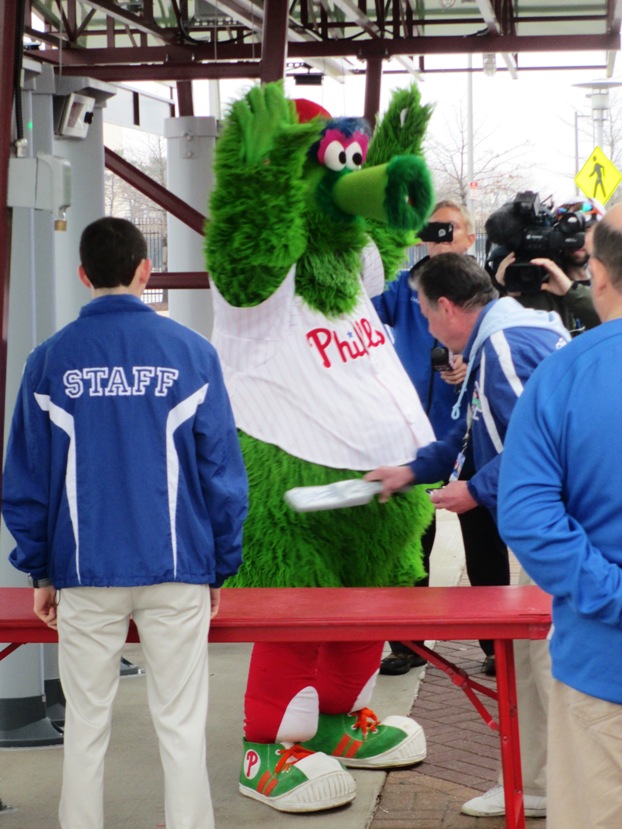
The Phanatic is also always willing to set an example for fellow fans.
Dancing with the grounds crew quickly caught on, too.
“The first night I did that, I tripped one of the guys by accident, the kid tripped and fell, and people laughed. That turned into me running around the bases and at each base I would knock one of the kids over, and then we would all gather behind home plate and dance. Fans were giving us standing ovations, because they’d never seen the grounds crew animated!”
In a rabid and brutally unsentimental sports town, it also didn’t hurt that the Phanatic could so effectively taunt the opposition. Tommy Lasorda, who could often be described as a cartoon character himself, once even wrote a blog post titled “I Hate The Phillie Phanatic”.
Raymond gets along with Lasorda and has read the post. Their feud was usually friendly, but it could escalate: “One night he just snapped, and he came out and tried to beat the ever-lovin’ you-know-what out of the Phanatic.”
The two smoothed it over, but Raymond retains his proud Philadelphian perspective towards the Dodgers icon. “He’s a wonderful ambassador for baseball; the only problem with him is that he’s a Dodgers fan from Philadelphia. Worst type of traitor we could ever have,” he laughs.
“I understood the psyche of the Philadelphia fan. I was one of them! I hated the Mets, I hated the Yankees, I hated the Celtics. And the Dallas Cowboys, to this day, I see Tony Romo in a commercial about pizza and I run and turn the TV off. I knew the fans would cheer when I stepped on a Mets hat or made fun of the Dodgers. I wanted to do that, because I hated the Dodgers, and I hated the Mets!
“It was that type of thing, and you put all those together and make a cartoon character out of it.”

The man and his dream.
(photo courtesy of Dave Raymond)
Today Dave Raymond brings a lifetime of experience as a world-famous character to Raymond Entertainment Group, which designs and builds mascots for sports teams and even corporations.
REG focuses on marketing the Power of Fun. It’s not an easy trick to blend two seemingly opposite concepts like fun and business, but Raymond can speak from solid experience.
“I watched my kids become Phillies fans because of the Phanatic. They wanted to go to games because they had fun. And they learned how to watch baseball and appreciate baseball. My daughters fell in love with the players because they looked cute in baseball uniforms. And now they are not letting me leave when I want to beat the traffic. From a marketing standpoint, the Phanatic’s building baseball fans.”
So in dealing with clients, Raymond emphasizes how valuable—to their bottom line—their furry representative can be. The goofy character in a bird costume is a worthwhile business investment, and for it to pay off, it needs to be done right.
“The first thing we do is make sure they understand the difference between a kid in a costume and a character brand. A character brand is a living, breathing extension of your brand, and a kid in a costume is just that.
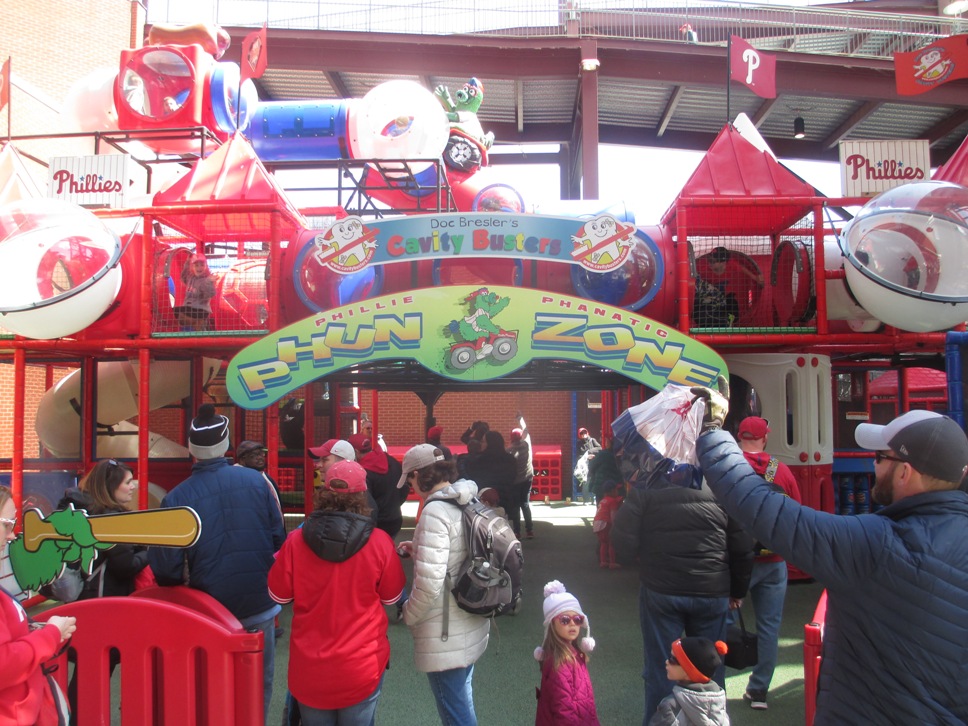
There’s even kids’ play areas dedicated to the Phillies’ enigmatic mascot.
“We research who they are in terms of the organization’s history, and who their community is in terms of the history. We help sketch out a back story that becomes the story of the character.
“They look at designs and they play Mr. Potato Head, they tell us what they like or more importantly what they don’t like, and then we go back and continue to draw until we get a design, we assign the copyright to that design, and then build multiple costumes for them. We help prime performers and train them.
“Also, what are you doing with the character brand? How are you rolling it out? How are you trying to get sponsorships? By the time we roll out the character, they should already know when they’re going to make all their money back, and when they’ll start making a profit.
“If they don’t do due diligence, frankly, I don’t want them as a customer. If they don’t want the best, they’re not gonna value the best.
“There are people saying I need a kid to get in my suit; right away I know that’s probably a client I don’t want. This is a character costume, it’s not a suit. It’s not a kid, it’s a trained performer. If you don’t want that, we’re not the ones for you. It’s a good thing not to waste time trying to make people buy from me. You’re not going to be able to service everybody.”
That’s not to say that REG doesn’t have a long list of satisfied clients; happy customers include the Cincinnati Reds, whose mascot “Gapper” is an REG creation, the Toledo Mud Hens, the Delmarva Shorebirds and the Phillies affiliate Lakewood Blue Claws, among many others. Raymond estimates that REG has created over a hundred characters, including at least ten for corporations.
“What separates us is that no one has the track record of success that we’ve had for not only designing and building, but also helping clients make money, drive revenue and brand, find performers and train them.”

Iconic enough to have his own mural at Citizens Bank Park.
It’s a seemingly natural progression for Raymond: from being an eager young intern who spent sixteen years bringing an inimitable brand of fun to a community, to now supporting a family by showing others how they can do it too.
“I’ve been to a lot of business training seminars, and they always ask what your ‘why’ is. My ‘why’ is, I want my marriage to be great, I want my kids to have good parents, and I want them to grow up and get married and have a great family. Every time I get a check for something, I’m going this is great, now I can pay my salary, and I can invest in what’s important to me, which is my kids and my relationship with my wife.
“Also, I’ve been delivering this presentation, which is the life lesson that the Phanatic has taught me, how powerful fun is to building a family and raising kids or whatever you’re doing. Using fun as a distracting tool is so powerful.
“That’s truly what I love doing more than anything else, getting in front of people and telling these stories and hopefully giving them something that helps them. I’m focused on going into Philadelphia, in the corporate community, and preaching the Power of Fun.”
If anyone knows how to appeal to sports types in the City of Brotherly Love, it’s Dave Raymond. After all, he’s lived it.
“One of the things I miss the most about not working as the Phanatic is the connection to the Philadelphia fan base. Once Phillies fans love you, they love you forever, and it’s almost impossible to do anything to get to the point where they don’t love you.
“That was the beauty of being the Phanatic.”
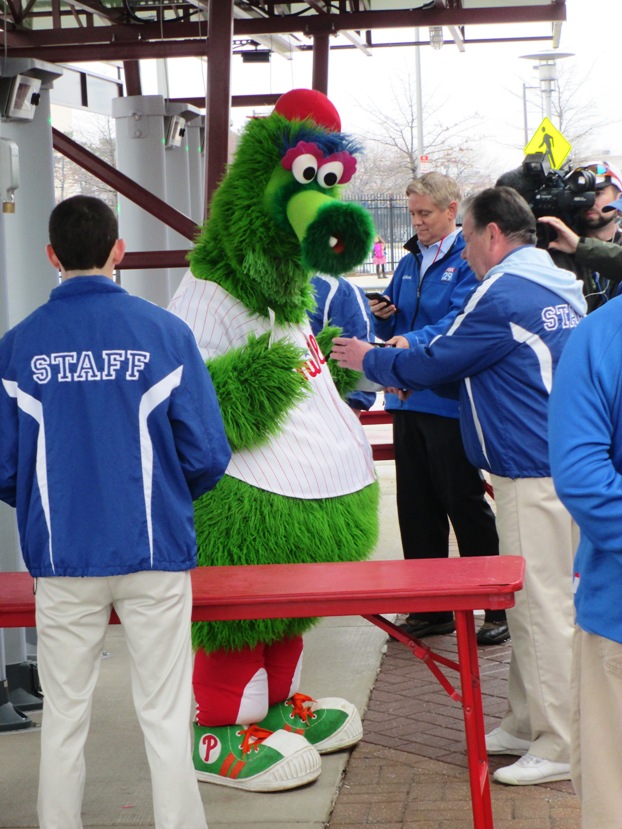
“I’m sorry sir, but your odor is scaring the kids.”
“This Costume Stinks!”
One service that Raymond Entertainment Group offers is costume cleaning…a surprisingly neglected aspect of mascot performance for many teams. The cleaning includes a “State of The Fur” analysis. A performer in a smelly costume is not a pleasant one, as Dave notes.
“The Phanatic opportunity for me, it truly was the best job you could ever imagine. But there were things about it that I hated. I hated that costume getting beer spilled on it, for example. I’m very anal retentive, I can’t stand things out of place, and it just drove me crazy. So I was meticulous about how I cleaned that costume.
“The first year, the people in New York that built it said they couldn’t wash it. You couldn’t even imagine what it smelled like. I finally just threw the thing in my bathtub with Woolite. I thought, I don’t care if I ruin it, it can’t smell like this anymore. When I got done cleaning it, it smelled great, and I wrote a note to the people in New York saying hey, this is how you clean it, and they were like, wow!”
Dave actually will frequently take on the cleaning tasks at REG. “This is what small business is about. I’m cleaning a lot of costumes myself. It’s just something that doesn’t require any great skill; you just spend a little time doing it. I have people that help and clean and restore the costumes. But I jump in there and do it a lot. It’s one of those healthy distractions for my mind.”
The “State of The Fur” analysis is for advice on cleaning and storage. “We try to give them feedback on what we all think they’re doing based on what is wrong with the costume. We want to have our eyes on it, because then our costumes last longer. Then people will say hey, when you get a costume from Raymond Entertainment it lasts for ten years.
“We prefer that rather than make money on rebuilding costumes, although we do that. It’s better that they know that their costume lasts three times longer than the competition.”

You too can dance on home team dugouts!
Mascot Boot Camp
Although Raymond Entertainment Group trains performers as part of their character creation package, Dave Raymond also hosts “Mascot Boot Camp”, where performers spend a weekend learning all about the business of being a character in a costume and non-verbal communication. It’s for everyone from new mascots learning the trade to longtime performers looking to rehabilitate their skills.
“It’s a great reality experience. If you want to experience what it’s like to be a mascot, come and experience mascot boot camp,” Dave says. “We’ve never marketed it for that, but it’s a lot of fun and they learn to move and communicate non-verbally, they learn how to take care of their costume, and learn how to take care of themselves physically.
“It’s a deep dive into mascot performance, there’s a real method to it now, where once it was Bill Giles telling me to go have fun.”
There’s another important rule of mascot performance: keep it safe.
“Lighting yourself on fire and jumping off a building and crashing into the ground might be something that people will talk about from now until the end of time, but you’re gonna kill yourself. And you’re gonna ruin the costume.”
REG’s “Angel Investor” – Sir Charles
Every business needs capital to get off the ground, and when Dave Raymond sought an investor for his idea to design and build characters, he found what he calls an “angel investor” who is well familiar with Philadelphia sports…Charles Barkley.
“When he would come to the Phillies games,” Raymond says of Sir Charles, “he would have fun with the Phanatic and we did a couple of routines here and there, where he was smacking the Phanatic around. It was fun. Charles invited me to hang out with him and some of his friends in Birmingham when I was doing minor league baseball in Birmingham one weekend.
“I just called him up, and he said my financial guy likes it, I’ll be happy to do it. His financial guy said listen, people haven’t paid Charles back over the years. I said, well, I’m dedicated to paying him back. I haven’t paid him every cent back, but he keeps telling me don’t worry, it’s no big deal. Charles just wanted to help. In the description of an angel investor, Charles Barkley’s picture should be in whatever dictionary or manual that is talking about angel this or that.
“Nobody knows that sort of thing. Charles has done that hundreds of times, he’s just a generous guy, one of the best people on the planet. I’ll be working until I close the business down to make sure he gets every penny back.”

Franklin has worked hard to get where he is today.
(photo courtesy of phillyfamily on Flickr)
Analyzing “Franklin”
Dave Raymond did some consulting for the 76ers in the rollout of their new mascot, a blue dog named Franklin. The humorous back story of Franklin on the 76ers website shows Franklin’s “ancestors” throughout Philadelphia history, including a missing bite out of Wilt Chamberlain’s “100” sign following Wilt’s 100-point game.
Raymond believes Franklin will be a success, despite the recent “controversy” surrounding the character—that Darnell Smith, who wears the Franklin costume, was a Knicks fan.
“One of the things he said to me was, I really need to be a Philadelphia fan, you gotta help me with who the Philadelphia fans are. He worked for MSG, and he was a mascot for the Liberty, the WNBA team. He’s done a lot of work with their performance team, the dunk team, all of that for the Knicks.
“Darnell is an awesome human being and an unbelievably gifted performer. I went to the first game that he was at just a couple of weeks ago and brought my kids, and he was kind enough to come up and interact with us. All the fans in our section were screaming for him. It was for kids by kids, which is what Tim McDermott said he wanted to do.
“What’s nice about it is that he recognized that getting in touch with the psyche of the Philadelphia fan was important. That just shows what a good performer he is. He’s an asset to the 76ers organization, I’m glad they got him.”

Being Relentless – The HEADstrong Foundation

The story of the founding of the HEADstrong Foundation is both heartbreaking and inspiring. I interviewed Cheryl Colleluori, the president of the Foundation, for Winter 2019 issue of JerseyMan. She is a remarkable, exceptional human being…a true warrior and survivor. You can read the article on JerseyMan’s website or you can view the PDF of the article here.

Nick Colleluori, the founder of the HEADstrong Foundation. (photo courtesy of Cheryl Colleluori)
Being Relentless
The HEADstrong Foundation is the brainchild of Nick Colleluori, who lost his life to cancer at the age of 21. Like Nick, the Foundation is relentless in helping patients and families affected by the disease.
Nick Colleluori sketched out the HEADstrong Foundation logo on his way to an operating room, in the midst of his battle with non-Hodgkin’s lymphoma.
His mother, Cheryl, remembers it well.
“He asked me for a piece of paper and pencil. I didn’t have a paper and pencil, but I gave him a napkin and he just started doodling. I wasn’t even paying attention. My husband and I were sitting there talking, trying to remain calm, giving him that assurance that this was going to be okay.
“They’re wheeling him in, and he turns the napkin around and said, ‘here’s the logo.’ I said, what are you talking about? He said ‘the logo for the Foundation. I’m starting it.’
“I thought to myself, man, this kid is relentless!”
When the 19-year-old three sport athlete was diagnosed with the disease that ultimately would take his life, he wouldn’t spend a minute letting anyone feel sorry for him.
“He made it really easy for us,” says Cheryl, who is now president of the Foundation. “He made the whole journey just very bearable, if you can imagine that. He was so upbeat, and you would never ever see a frown on his face. I felt very privileged that I was his mom.”
Nick spent his 14-month fight…which was 11 months longer than doctors initially anticipated…noticing every resource that was lacking for cancer patients and their families. Challenges like financial help, a place to stay during treatments, and the need for understanding and support. As his mother says, at a time when he could have been selfish, he chose to help others instead.
Today the HEADstrong Foundation he founded is doing just that, in a huge way.
They connect patients with survivors to speak with and mentor them through the ordeal. They host events and provide entertainment for patients throughout the year, including an annual Thanksgiving feast at the Hospital of the University of Pennsylvania. And patients coming to Philadelphia for treatment can stay in Nick’s House, in either of two locations in the Philly suburbs.

Nick’s House in Swarthmore, PA, a beautiful place to be, especially in the fall.
The idea for Nick’s House was born out of the Colleluoris visiting NIH in Bethesda, Maryland, for a clinical trial.
“We were in an 8×10 room and there were seven of us,” Cheryl remembers. “We were on sleeping bags. We were so grateful, but it was not conducive for a long term living arrangement. We met a family living out of their car, which is not unusual. We thought, let’s do something.
“Our first Nick’s House was born seven years ago, and we refinanced our house to purchase this house. It took my husband six, seven months to renovate. The second home in Swarthmore opened in February after one year of renovation.
“We’re not just children, we’re all ages. Pediatric, geriatric. We are all cancers. And the common theme is that they’re traveling a distance of 50 miles or more, and they’re coming here for an extended period of time. Nick’s House becomes their home. They can read a book, be part of the neighborhood, go for a walk, you know, they’re in a safe and secure environment.
“I just love it. I’m so proud of it. The greatest gift for me is seeing complete strangers become one family.”
That the Colleluori family has been there is their greatest asset in helping other families.
“When people come to Philadelphia for treatment, they’re leaving behind everything they know. We become their family and their support system. We are very family rooted, hands on, in the trenches with the families. We are that family. We were that family. We understand everything that they’re going through.
“I get this a lot: When will I know, when should we make the decision, if things aren’t going well? And my response is, you’re going to know. I also say, don’t go there until you have to.
“A lot of times the minute you hear the diagnosis, oh my God, my child’s going to die. Well, guess what, we have seen hundreds of children that are still here with us, that have made it, that have survived. My message to other parents is keep positive no matter how bad it gets, and don’t go there.
“That little bit of information was shared with me, because I went down that path too. You hear the word cancer and you’re just in such a tailspin. You don’t even know what to do next.
“One of the greatest compliments I’ve ever received was from a mother of a terminally ill child. She held my hand and looked into my eyes and says, you are my role model. Those are the only five words that I ever need to hear, to know that she can see me standing still. I’m still standing.”

Cheryl Colleluori, with her son’s uniform providing the inspiration.
Cheryl Colleluori is never afraid to be human. She has no problem choking up and occasionally pausing to gather herself, even while speaking with a writer she’s never met over the phone. But in mere seconds she is back in the game, speaking of the goals of the Foundation. “Be relentless” is its motto.
JerseyMan has profiled dozens of successful entrepreneurs. They almost always speak of the importance of getting back up again. That there is no substitute for perseverance.
If you want to see an example of someone who relentlessly gets back up, it’s Cheryl Colleluori. She is still going strong every day, meeting with patients, consoling them, supporting them every way she can. Like her son, she’s as great a teammate as you could ask for.
There are, of course, moments. The blow life dealt her was enough for her to faint dead away in her first visit to a hospital, to distribute “Comfort Kits” to cancer patients.
“I stepped out of the elevator and passed out,” she remembers. “Because all of a sudden what hits you is the smells, the sounds. You know when you’re walking into the room. I was thinking, I don’t know if I can do this.”
But she did. Because her son’s relentlessness still gives comfort and hope to thousands. Cancer may have taken his life, but even now, he won’t let it beat him.
After Nick’s passing, the family was so heartbroken that they sought a medium to possibly bring them some comfort. Cheryl says that to their surprise, the medium knew things that no one could have known, including details about Nick and his girlfriend of eight years, Jordan, exchanging wedding vows the night before he passed.
“The medium said to me, ‘your son is telling me that you are his mouthpiece.’ When I got the phone call two days later to speak, my husband said you can do this for our baby. That was the start, and the rest is history.
“He is guiding us. There’s no doubt in my mind that he is still providing the direction and my inspiration.”
When the doctors could do no more for Nick and sent him home, he took the car keys from his devastated father and let his mother drive. On the way home, he spoke with her about his final wishes, including for Cheryl to take HEADstrong as far as it could go.
“He said, Mom, look into my eyes and tell me that you can do this for me. His exact words to me were, ‘I want other people to benefit from my life.’
“How do you say no to that?”

Helping The Foundation Stay HEADstrong
The HEADstrong Foundation has been an enormous success since the passing of its founder Nick Colleluori in 2006. They have raised over $14.4 million and have assisted over 15,500 families affected by cancer. In addition to two Nick’s House locations that can simultaneously host eight families, they served Thanksgiving meals to five floors of patients in 2018, have hosted dozens of fundraising events and have delivered hundreds of their “Comfort Kits”.
But as Cheryl Colleluori will tell you, it’s not without challenges. Nick’s House requests are frequently coming in, as more families travel from hundreds of miles away for specialized treatment that is only available here. She notes that there are 280 families a month in need of housing just in Philadelphia.
Families at Nick’s House are charged nothing for their stays, which can often be 50 days or more. This is in addition to their financial grants for families struggling with costs, dinners and events, and the multiple other services HEADstrong provides to families.
“We want to have the greatest impact we can in Nick’s name,” Cheryl says. “We want to help as many people as we can, and make sure we have the right people in place that bleed like we bleed, that breathe like we breathe. We have a lot of people that we’ve helped that have lost their loved one and they now have an opportunity to set up fund in that loved one’s name, and paying it forward for the next family. And that’s been a nice opportunity of growth for us.”
Nick’s House and the HEADstrong Foundation subsists entirely through volunteers, partnerships and donations. If you’d like to contribute or volunteer, you can find out how at https://headstrong.org.

Cheryl in Nick’s House, bringing hope to those who most need it.
The Comfort Kit
One of Nick’s innovative ideas for helping cancer patients was borne out of the experience of being on call for hospital visits. It’s called the “Comfort Kit”, and the HEADstrong Foundation regularly delivers them to cancer patients.
“A lot of times when someone’s admitted to the hospital,” Cheryl says, “you need to report right now because there’s a room available. Or, you’re in the emergency room and you’re admitted on the spot. You don’t have anything with you from home.”
The Comfort Kit includes a set of items that people without experience in this realm probably wouldn’t think of, as she explains:
A journal and a pen – “2:00 in the morning you wake up and ‘oh my gosh, is this normal? I have a question for the doctor. Am I going to remember?’ There’s your journal, jot the question, write it down.”
A blanket – “It provides warmth and comfort and it personalizes the room.”
Tissues with aloe – “Tissues in the hospital are so paper thin.”
A toothbrush and toothpaste – “A soft bristle toothbrush, because toothbrushes in hospitals fall apart when you use them.”
A gift card – “I don’t have any money and I need to get out of the parking lot. Or, I could really go for coffee, let me run down to the cafeteria. Oh darn it, I don’t have any money. Well, don’t worry about it, because there’s your gift card.”
Information about HEADstrong’s Peer Support – “You just never know when somebody’s losing it on the floor and they want to talk to somebody.”
Comfort Kits are hugely appreciated by patients, Cheryl notes. “It’s just a great way to enter somebody’s room and say, hi, how are ya? I’m Cheryl Colleluori with the HEADstrong Foundation. I’m thinking of you today and I hope this makes you smile. I hope that you know that there’s somebody here fighting for you that you don’t even know. A lot of times people are like, I was hoping you were going to come, I heard about this!
“I get great reward out of bringing a smile to someone’s face and my team. We go down with about 15 volunteers, and every one of those volunteers are survivors that I met as I handed out their comfort kit.”
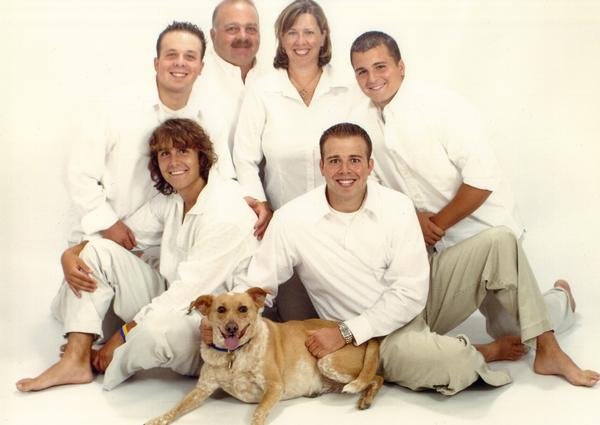
The Colleluori family, the best teammates you could ask for. (photo courtesy of Cheryl Colleluori)
The Mental Game
The HEADstrong Foundation’s Peer Support program connects survivors and family members to share their deepest and most private concerns. Generally they will find a survivor of the same age group and background to speak with a patient or family member.
“My sons are very involved,” Cheryl says. “They talk to siblings, my husband talks to dads, I talk to moms and dads, and the peer support is not over when someone passes. If the person’s gone a couple of years, it doesn’t mean the relationship with the HEADstrong Foundation is over. We’re still very highly involved with families.”
HEADstrong is relentless in helping people stay as upbeat as possible. But Cheryl absolutely understands that it’s almost impossible for patients not to get down sometimes. “There’s a lot of sadness. We cry right with people.
“We try to talk about other things. We try to get people’s minds off of the fact that their health is declining. If somebody wants to talk about it, I will, we understand. Nick was tired, we know. But if we get somebody’s mind off of it, they forget. A lot of it is a mental game.
“In two weeks, we’re going to the Sixers game, and we’re taking 26 people with cancer with us. We do the programs in the hospital, we have people in wheelchairs and oxygen, and IV poles. They’re getting blood and getting chemo and we bring them into the room and have a magic show, or we play bingo. Or we have jazz night and they’re singing and clapping. If it’s for an hour, we’ve just improved their mental state.
“We’ll do art therapy. One guy, I’ll never forget, he was so weak. We took him back to his room and the next thing we know, he’s back. The nurse has got him back at the door and I said, are you okay? He’s like, ‘I have to finish this for my daughter.’
“He finished the painting, and I took him back and he said, ‘can you place it right there for me? I’m going to take a picture, I’m going to send it to her.’ He said, ‘you’ve given me the motivation I needed to get the heck out of here and get home to my daughter.’ We still keep in touch with him today.
“It’s just those little things to help people get through the darkest days.”

Surviving Until Tuesday – Sergeant Andrew Einstein

Andrew Einstein is one of our nation’s true heroes, yet he was driven to the brink of suicide resulting from a head injury and lost sense of meaning. JerseyMan sent me to interview him as he told me what real strength was to him. You can read the article on JerseyMan’s website here, or view the PDF of the article here.
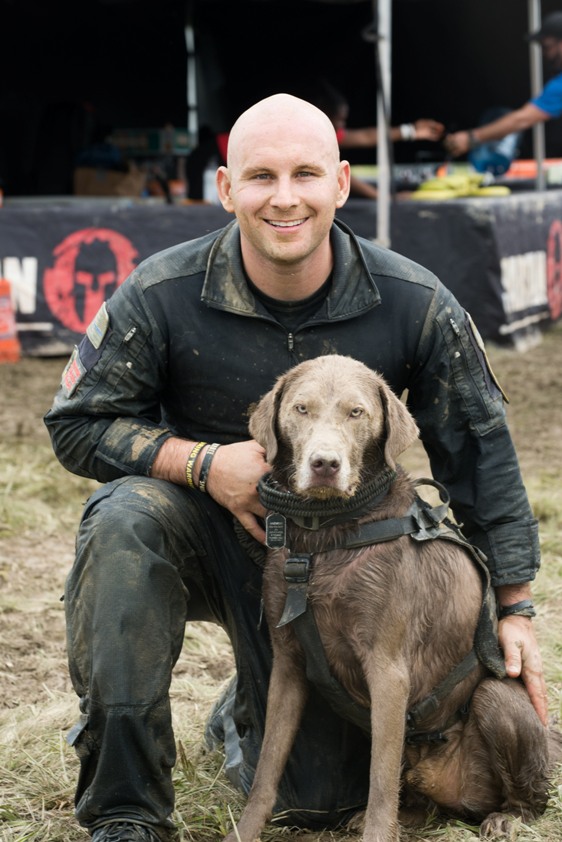
Sergeant Andrew Einstein with Gunner, the Silver Labrador who was there to save his life. (photo courtesy of Andrew Einstein)
Surviving Until Tuesday
Camden County Police Officer and U.S. Marine Sergeant Andrew Einstein speaks openly about being on the brink of suicide, pulling himself out, and living a life with purpose again.
On August 5, 2011, in the Sangin Valley region of Afghanistan, Sergeant Andrew Einstein of the U.S. Marine Corps sustained a brain injury from a grenade attack.
He didn’t think it was a big deal at the time.
“Kids would throw rocks at patrols and stuff to mess with us,” Einstein says. “I remember looking down and going, it’s just a rock. I saw there was an Afghan soldier, and his eyes were just like…I looked back down and said, oh, that’s not a rock. As I went and turned to get away from it, I got a couple of steps and it went off.
“I remember grabbing my ear, my ear hurt so much. I yelled, I fell into one of the rooms. I crawled out and that same Afghan soldier, he was wearing a white shirt, he fell to where I was and his white shirt was red.
“I remember being really confused. I said, why is his white shirt red? He obviously had received some shrapnel, and I put a tourniquet on one arm and then I went to put a tourniquet on another arm. They took care of him, and I sat back and lit a cigarette.”
He wasn’t bleeding, he didn’t lose any limbs, and he had no bullet holes. Just migraines. To Einstein, it wasn’t a “real” war wound…especially happening on the same day that fellow Marine Daniel Gurr was killed.
He was, he knew, ready to get back to the fight.
A country that values freedom never has enough people like Andrew Einstein wearing military uniforms. But as it turned out, the injury was a big deal. Less than a year later, it was a contributing factor in his decision to end his life.
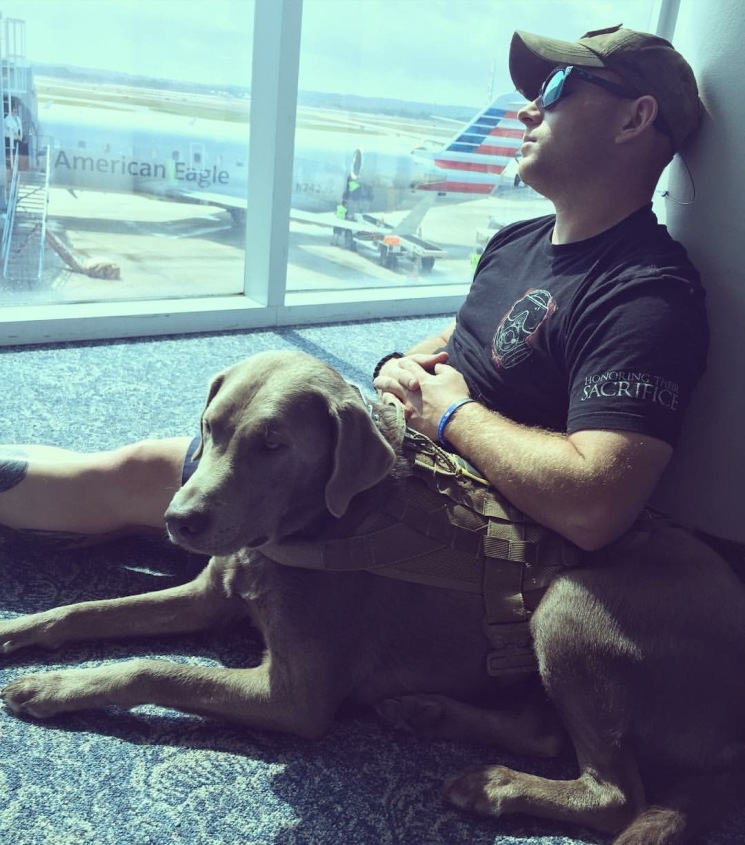
Einstein with Gunner, keeping him in the fight. (photo courtesy of Andrew Einstein)
That, and a lost sense of meaning back home.
“Coming home feels great,” Einstein says. “Then you realize that life went on, and you’ve got to figure out how to get back into your old life. And then comes a time, at least for me, where I said, I want to go back. I need that responsibility and that purpose that I had over there.
“I know the head injury really caused a lot of issues. The biggest issue was the hearing loss and then the memory issue. I was afraid that if I got help, they would take my badge and gun and say, sorry, you can’t be a cop anymore. I’ve been a cop since I was 18. That’s all I know. And I love being a cop. Aside from being a Marine, this is my life.”
As Einstein increasingly saw it, it was a no-win. Fight your losing battles alone or give up the responsibility. As time went on, the stress of what he perceived to be a meaningless life continued to mount.
By May of 2012, he couldn’t take it anymore.
“I wrote letters to my family. I’ll never forget what I wrote to my youngest sister. I apologized. Because up until that point, she looked at me as this hero. I was her brother, a police officer, a Marine who went over and fought for our country. I said, I’m sorry for lying and making you think I was so much stronger than I actually was, and I’m not a hero. I’ll never forget writing that because those words were the hardest.
“I put the bottle of pills next to my bed. I went out and drank so much that my friends plopped me on the couch. No one knew that 15 feet into the bedroom there was a bottle of pills that I’m planning to kill myself with. I remember waking up the next day, and I was disgusted. I couldn’t even kill myself.”
The date Einstein picked to be his last was fortuitous. He wanted the new dog he had agreed to pick up the following morning to have a loving home, and not be his family’s responsibility. After failing his suicide attempt, he went to pick up the dog.

Officer Andrew Einstein at the office.
It turned out that Gunner, his new Silver Labrador, didn’t need a loving home. He needed a purpose too.
“As soon as I picked the dog up, I said, ‘I can’t kill myself, because I’ve got to be there for this dog now.’ All of a sudden I had responsibility again. Even when I was still doing the things I was doing, he was there for me. He didn’t judge, he didn’t care; he loved me. He would lay right on me.”
Einstein gives Gunner credit for saving his life. But he soon caught another break when his chief at the Riverton Police Department, John Shaw, could see he wasn’t well.
“He said, I don’t want you to lose your job, and I want to help you. I said, well, if he’s reaching his neck out for me, who am I not to try and get better.
“I went to doctors, I started going to groups and talking about the issues. My dog and I went into training, so he could become a service dog for me. It was definitely two steps forward, one step back, but each step, it got brighter and brighter. It took time, but we just started getting better and life became better.
“You always say, if you could talk to your 18-year old self. If I could talk to my 2012 self, I’d say, ‘Get off the couch and go get help. You can do this.’
“I’m telling you this is strength…raising your hand and saying, ‘I am not okay. I need help.’ One of my biggest things that I speak to now is with the first responder community, when there’s bosses or administrators to understand how or what to do if they have one of their personnel go: ‘I’m not okay.’
“However bad it is in your life,” he adds, “I can’t tell you when it’s going to get better. Hopefully it’s the next day. In reality, it’s not going to be the next day, or the day after that. But if you fight to get better, I promise you at some point, it will get better.
“I tell people, if you’re going through something, not just suicidal, you’re going through a gray dark time. If there’s something in your life that you enjoy doing, whatever it is. If once a month, every second Tuesday you’re going to play basketball with your friends, and you know that in that hour you’re totally relaxed and everything is great?
“Live to that Tuesday. Because you know each second Tuesday of the month, you’re going to have that hour of peace. No matter how bad your life gets in between, live for that Tuesday. And then live again for the next Tuesday.
“If you only have that, live for that Tuesday.”
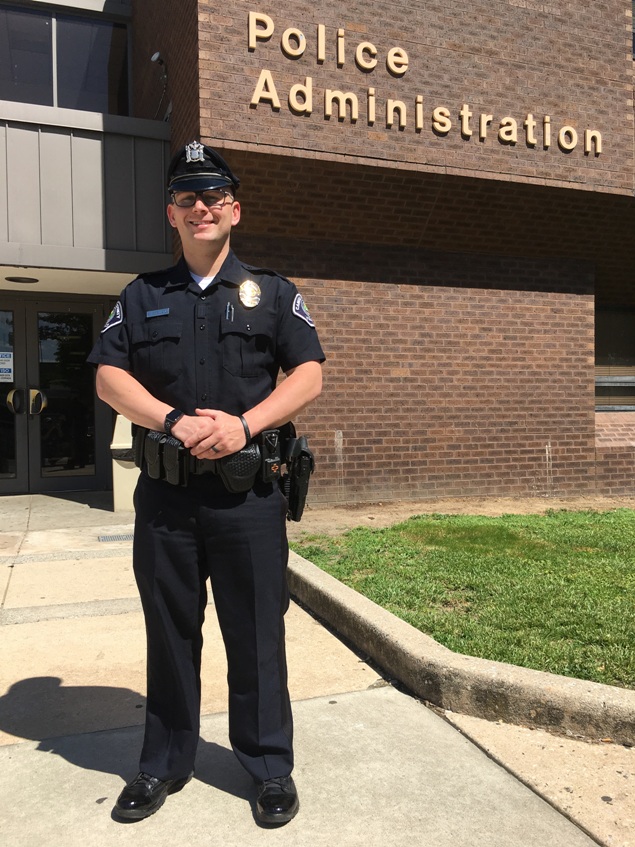
Serving the community, with his own experience.
Andrew Einstein is no longer surviving until Tuesday. He is now an officer in the Camden County Police Department, where he uses war and post-war experience to break trust barriers with city residents.
“One of the first things they said was: we know about your story and we want you to tell it, because we want you to help others.
“In this city, we have people in crisis every day, and these people have lived hard lives. I have to break the barrier, the same barriers I had to break in Afghanistan, to show them, look, I know I can’t relate to your life. But let me in, open the door a little bit, let me show you that I’m here to help.
“We try to de-escalate the situation as quickly as possible, and when someone’s in that moment, I can say, hey, hold on. I’ve been there. Guess what, May 5th, 2012, I was where you were.”
“I love getting the bad guy off the street. But I also love talking to the person in crisis or the person who just wants to talk. Dealing with the people here, it’s not all about busting the bad guys. Sometimes it is about throwing the football with the kid on the block or playing basketball. It’s showing the people that you serve, that you’re a person.
“I don’t say being suicidal helps you become a better person in the long run. It’s you take what life dishes at you and you learn from it.
“What I’ve dealt with in life, I’ve been able to use to mold into a better life.”
Today, the city of Camden has Officer Einstein and Gunner to thank too.

It’s All About The Bread – Sarcone’s Bakery, Philadelphia

The world’s best bread? Maybe. JerseyMan sent me to write a piece about Sarcone’s, the fifth-generation Philadelphia bakery. A lot of fun to write, and an iconic place to visit and pick up some truly amazing bread. You can view the PDF of the magazine article here.

Bread worth waiting in line for.
It’s All About The Bread
Sarcone’s Bakery is in its fifth generation of baking bread for Philadelphians.
If you’re wondering just how good the bread is from Sarcone’s Bakery, consider that the winner of the Travel Channel’s “Best Sandwich in America” changed their rolls to Sarcone’s…after taking the prize.
In 2012 Adam Richman’s popular show spent ten episodes—with several elimination rounds—deciding which offering of meat on bread was the best in the nation. DiNic’s Roast Pork in the Reading Terminal Market won the hotly contested honor.
“The day after he got that trophy,” says Louis Sarcone Jr., the fourth generation owner of the venerable bakery, “the first thing he did was switch his bread to Sarcone’s.”
A bold move, to say the least.
“People were blown away by it,” Sarcone remembers. “You just won best sandwich in America. Not Philly, America! His answer was, we want to stay the best. How do you improve our sandwich? We improved our bread.”
To those familiar with Sarcone’s Bakery on South 9th Street, though, DiNic’s switch isn’t as earthshaking as it appears. The irony is that in changing a national award-winning formula, DiNic’s turned to an institution that hasn’t changed anything in 96 years.
At least they went with someone who has the technique down.

Three generations of bread-making Sarcones.
Sarcone’s has survived two World Wars, the Great Depression and every recession since. But perhaps more remarkably, it has survived what can be the toughest challenge several times…the next generation.
Sitting relaxed on the store’s window ledge, Lou Jr. shares the secrets of the family’s continued success. His son, Louis Sarcone III, stands patiently nearby, occasionally offering his own thoughts but seemingly more to learn the art of the interview from Dad…who is clearly versed in giving them.
“If you don’t listen to the generation before you, something gets lost,” Lou Jr. says. “You have to pay attention, and that’s the hardest thing for generational businesses, listening to the one before you. Even if you disagree with that person, you can really screw up a family business if you don’t listen.
“My grandfather, the first thing he told me was, if you put too much food in your mouth, you can’t chew. The younger generation sees a business, they see financial, they see money, they see an opportunity for the brand. If you try to expand too much, you lose something. You lose control of a business, you may lose a recipe, you may lose the quality of the product.
“But if you keep your product the same and keep trucking along, your customers will always come in because you make a great product.”

If you’re going to expand, do it next door.
This isn’t to say that there’s never been attempts to expand the name, or even ill-advised ones. Sarcone’s Deli just up the street uses the bakery’s bread, and they are doing just fine. But opening delicatessens elsewhere proved a challenge. Possibly with his grandfather’s words in the back of his mind, Lou Jr. pulled back the reins.
“My first cousin, Anthony Bucci, was an executive chef for the Wyndham Plaza. He got tired of working for big companies. He opened his own deli in Limerick; he’s been there 28 years. We opened the deli about 12 years ago. I let him run it. The only thing I’m involved in is paperwork and making bread.
“We expanded; we had five delis not including our own. My father had gotten sick at the bakery, and my cousin had a heart attack and was out for a year and a half. I couldn’t do day-to-day operations for two businesses. We put too much food in our mouth, I did.”
The younger Sarcone adds: “You have to keep an eye on the franchises, because you want everything to be the same. They’ll start adding things that don’t belong.”
Lou Jr. agrees. “We use Di Bruno cheese. They might go to the supermarket and get it a dollar cheaper. Stuff like that happens. You don’t want it to happen, but it could happen. So before we had that black eye, we closed the deli.”
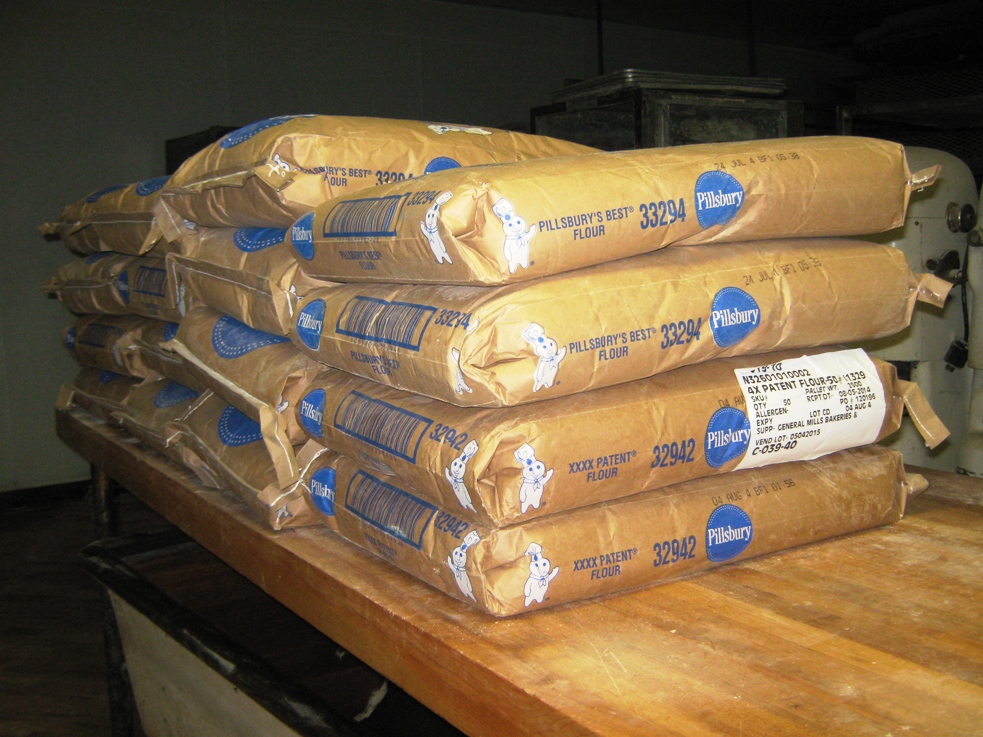
The key ingredient. Actually pretty much the only ingredient.
So while Cherry Hill residents may have been disappointed, Lou Jr. was content to go back to running the bakery. No reason to change what worked for four generations, be it the nature of the business or the recipe for the bread.
“I’ve never changed the recipe,” he notes. “Sometimes the quality of the flour may change, maybe protein levels aren’t there and you have to add a little bit of protein. We do have to adjust for that. But as far as changing the recipe, no. It’s water, flour, salt and yeast.”
But lest anyone think they can bake bread as good as Sarcone’s once they know the ingredients, Lou describes the craftsmanship of the baking process. The real secret? Time.
“It’s a six hour process. We have a guy that comes in at 12:00 every night. The dough sits for two hours. The bakers start coming in at 2:00 AM, processing the dough, the various shapes, sizes, and measures. It takes two hours to do that, so that’s four hours. Then they have to turn it into a loaf of bread, turn it into a roll, so by the time the bread is mixed and comes out of the oven, it’s six hours.
“No commercial bakery shop is going to wait six hours; they’re going to put in preservatives and meet the demand.”
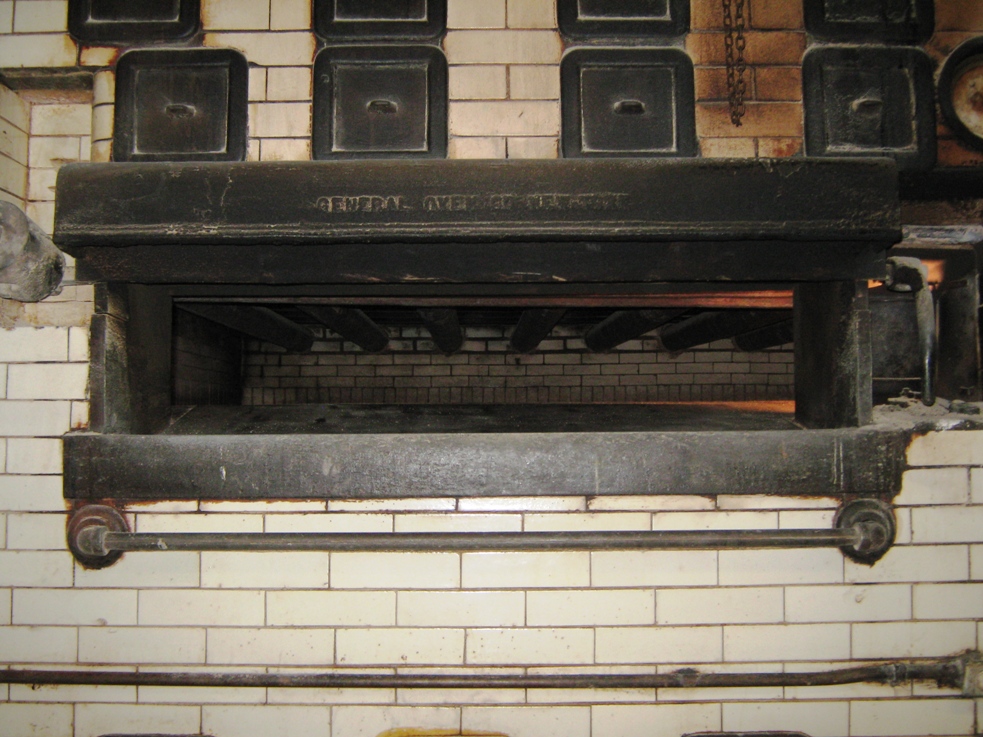
Ovens made before “planned obsolescence” was a thing.
Brick ovens make a difference too, as the younger Sarcone points out: “What also makes us unique is our ovens. They were built in 1920; you can’t find them anywhere anymore.”
Dad continues. “The alternative is metal, an oven that revolves. The only thing that revolves in a brick oven is our bakers. We go in with 15-foot sticks and move the bread around ourselves, to the hot spot in the oven.
“Ever see trucks that say ‘hearth-baked bread’? That’s baloney, because nobody uses brick, especially in a commercial bakery. Ours is hearth baked, there’s no metal in between the bread, the dough, and the hearth.
“It’s an art. There’s no timer, no thermostat on the oven. Well, there is, but they’re untrue. So it’s all knowing the dough, how loose it was or how cold it was or how warm it is out, how long it’s gonna take. And the sound; you pull a loaf of bread out and tap the bottom, you hear a certain sound, you know it’s done.”
It takes time to master the craft, so Sarcone keeps people around that do. “Bakers have been here at least ten years or more. They like what they’re doing, so they stay. I treat everybody like we’re family. Morale is good here, considering people are getting up at 2:00 in the morning.”
As Lou Jr. freely shares, the secret isn’t an ingredient or brand of yeast…it’s taking the time, sticking with what works, and not putting so much food in your mouth that you can’t chew. That’s the family formula that has kept the store in Philadelphia for nearly a century.
There have been plenty of awards and gushing press through the years, but Lou Jr.’s proudest moment was the locals’ response to a debilitating fire.
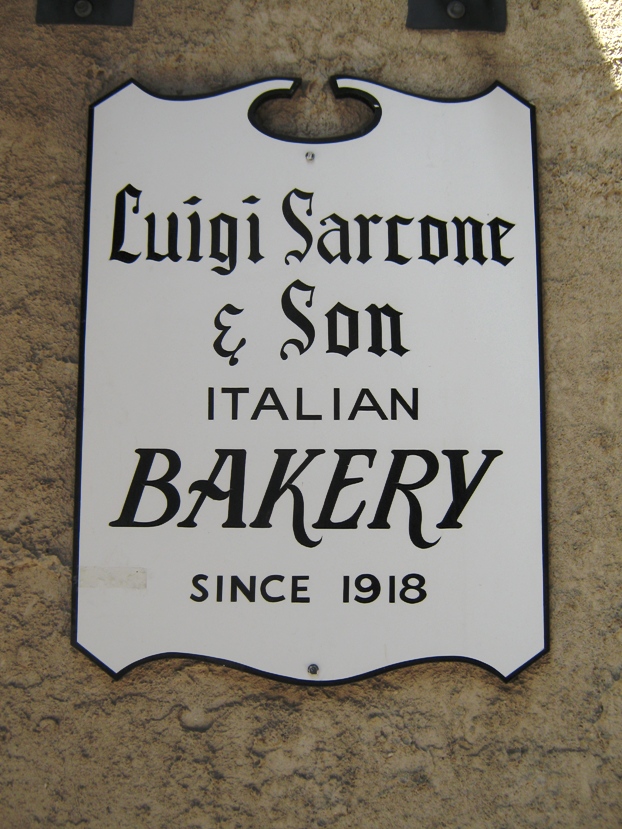
Beloved enough to inspire civic pride.
In October of 2000, a Molotov cocktail was thrown through the window, burning the front of the store down. The culprit was never captured nor the motive revealed—“there’s a million stories out there, pick one,” Lou says—but the city came together to literally lift the bakery from the ashes as quickly as possible.
“The fire department, the city council, the mayor, they came here to help us get open because they didn’t want to see us leave. Contractors, electricians, inspectors, zoning people, they were all here the next day. We didn’t have to wait. They were waiting for us.
“We were open a week next door. We moved our storefront into the packing area. It wasn’t pretty, but people actually liked that better. They saw men work, they saw the flour, they saw everything. We spent thousands to replace the store; they wanted the old way!
“That was something I’ll never forget, the way the neighbors and the city came together to help us.”
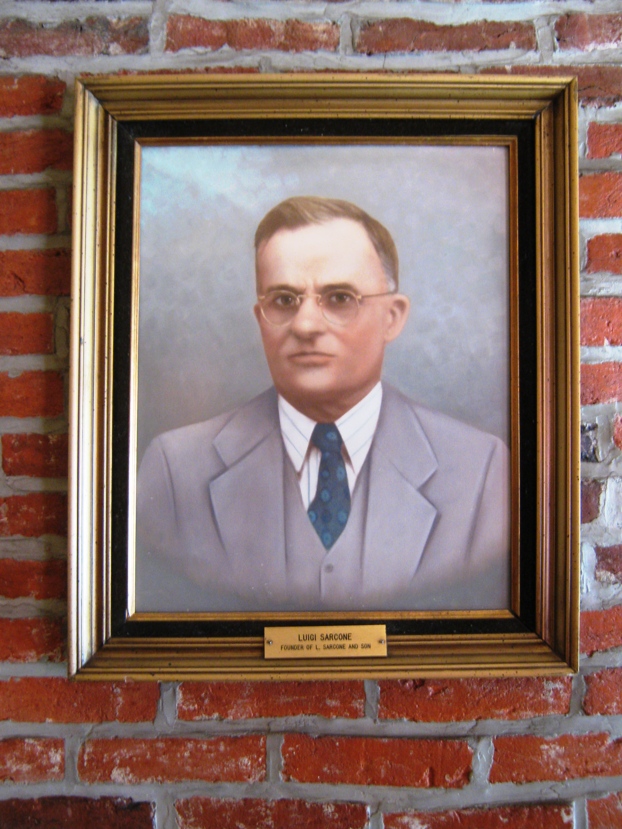
The first Sarcone, still overseeing the bread tradition.
Fourteen years later, Sarcone’s remains a beloved institution in Philadelphia—and a must-visit for tourists. Customers gather daily outside like music fans once waited for concert tickets before the Internet. Lines begin forming at six in the morning and sometimes extend for blocks.
To Louis Sarcone Jr., it’s the definition of success.
“Remember Springdale Road and Route 70 in Cherry Hill, used to be called the Point View Inn?,” he asks. “A little house. That guy had lines for years back in the 70s. He turned it into what it looks like now. Because he got massively big, he closed within a year, then it was Pizzeria Uno, now it’s a PJ Whelihan’s. That place, I could always remember, it was the longest lines ever for a family restaurant.
“You want lines. You want people to have a hard time getting in. Why is that line two blocks long? We gotta try it!”
Did this post make your day a little bit?
I hope so. If it did, I would really appreciate your support.
When you use this link to shop on Amazon, you’ll help subsidize this great website…at no extra charge to you.
Thanks very much…come back soon!
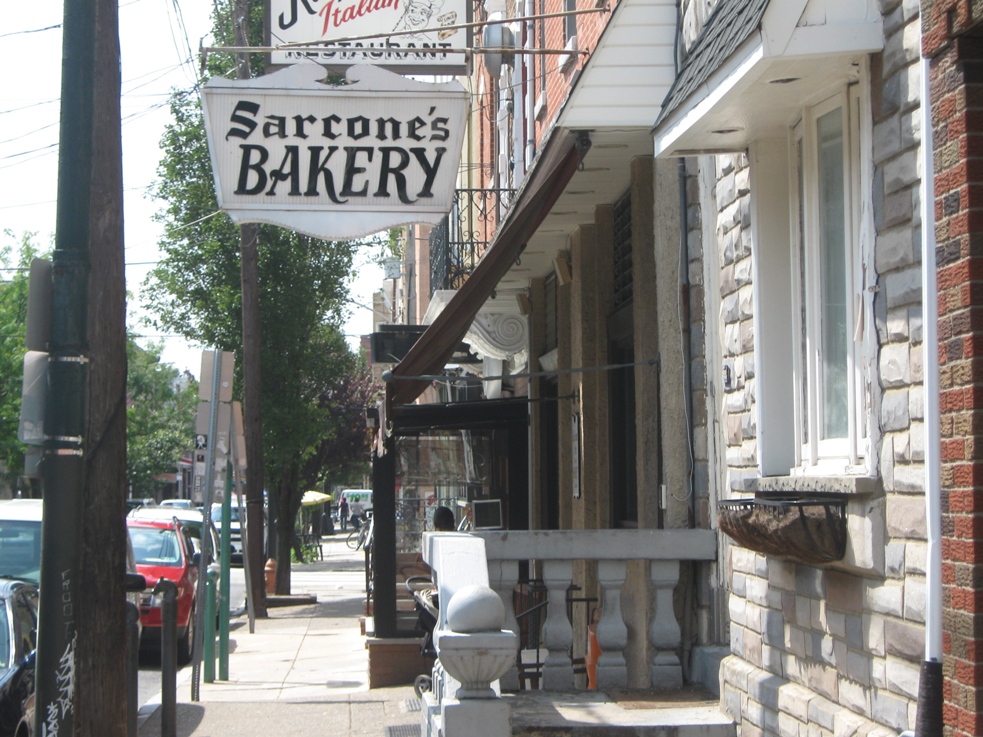
Chugging along since 1918.
Sarcone’s Bakery has been a Philly institution longer than…
…the Flyers, Eagles, and 76ers
…the Ben Franklin Bridge
…the 215 area code
…the Daily News
…WIP, WFIL, and WCAU radio
…the PSFS Building
…30th Street Station
…SEPTA
…the Schuylkill Expressway
…Pat’s and Geno’s cheesesteaks (and all of their successors)

Their Bestness probably reaches beyond Philadelphia.
Accolades for Sarcone’s from Yelp Nation:
In 64 Yelp reviews, Sarcone’s averages four and a half stars out of five. Some quotes from the bakery’s fans:
“In footie pajamas I offer night time prayers thankful that Sarcone’s exists and it’s so close to my house…’cause good bread they got…you seriously could put just about anything on that seeded Italian bread and it would be glorious.” – Kathleen D., Philadelphia
“It’s that alluring smell that makes you just want to rip off a piece and eat it. It doesn’t need butter, it’s perfect as is.” – Vinny P., Philadelphia
“My local farmer’s market has a small place in it that sells sandwiches. My Dad found out they were using rolls from Sarcone’s and asked to buy whatever they had leftover at the end of the night, and offered over triple what they originally paid for them. The Best Bread. Period.” Michelle M., Wilmington, DE
“You, along with many others, will line up to hopefully buy a long seeded roll, sandwich rolls, or anything else that comes fresh from their ovens. It’s a work of delicious, crispy crunchiness that cannot and will not be denied.” – Tyler R., Philadelphia
“Dear Sarcone’s – I miss you dreadfully. Whether I ate your bread fresh as I walked home, turned it into a hoagie or slathered it with garlic butter and baked it to soft yet crispy perfection, it always made the meal. There is no way to express the sadness I feel in my heart and in my mouth at now living so many states away…Love, Amelia” – Amelia L., Brighton, MA
“This place is why Philly can make a case for being the sandwich capital of the world.” – Chris W. Philadelphia
“I don’t even consider a Hoagie a Hoagie unless it’s made in a Sarcone Roll.” – Bruce B., Philadelphia

Yes, you can get some fine pizza here too. With a great crust.
Staples of Sarcone’s:
Seeded Italian Bread – “We’re known for putting seeded Italian bread on the map,” Lou Sarcone Jr. says. “If I stop making seeded bread, if I only made plain bread, Liscio’s would have to change their bread to plain bread. They couldn’t fake it out being Sarcone’s.” Primo’s Hoagies started out with Sarcone’s seeded Italian bread, until the expansion made it impossible for Sarcone’s to keep up the supply. “Once they establish their name they leave me,” Sarcone says.
Tomato Pies – Sarcone’s tomato pies on their garlicky baked Sicilian crust are actually a popular breakfast item with locals; as the Zagat website mention of Sarcone’s describes it: “The end result is almost like what you get when sweeping up leftover spaghetti sauce on your plate with the end of your bread.”
Pepperoni Bread – The pepperoni rolls (or sausage rolls, if you prefer), contain a generous amount of meat for such a delicacy, and the soft crust of the bread contains just the right amount of olive oil. If they’re out of pizza slices in your next visit, try one of these.
Bread Crumbs – There isn’t often leftovers in a bakery that usually sells out its products in the early afternoon, but Lou Sarcone knows what to do with them. “We let it get stale for four or five days, then grind it up and sell it as bread crumbs. Restaurants buy them by the hundred pounds; walk-in customers buy it by the pound,” Lou says.

The Game of Balls – Major League Bocce

Did you know that the game of bocce has existed for over 7,000 years? That’s longer than most religions last! JerseyMan sent me to write about Major League Bocce and the growth of the league. You can view the PDF of the magazine edition here.
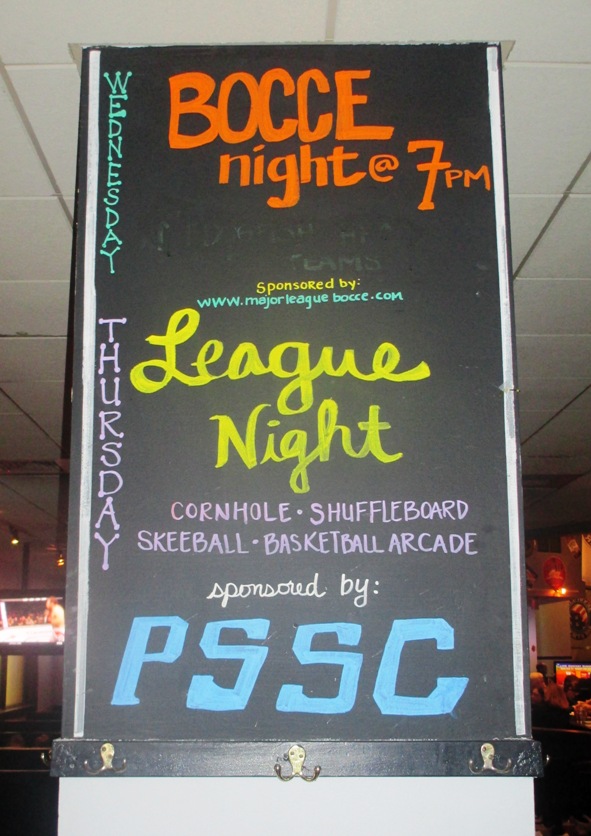
“It’s Bocce Night Everyone!”
The Game of Balls
After 7,000 years, a group of friends finally made obvious what’s so great about the game of bocce.
Listening to Sarah DeLucas, it all started when she and a group of friends were cooped up indoors for a hurricane party. And someone said, “Let’s start a bocce league.”
“Like most great ideas that come about, we were just drinking at someone’s house,” the part owner of Major League Bocce says.
Okay, maybe it wasn’t that simple. This free-thinking group was actually looking for a socializing sport. Something beer-league friendly that players wouldn’t take too seriously. But as DeLucas explains, once bocce was suggested, it seemed obvious.
“I was relatively new to Washington, as were some of my friends. We played in a kickball league. We liked the concept of social sports; it was fun to go do a recreational activity and then go to the bar after games and socialize. But we didn’t really like kickball. There were a lot of rules and regulations that we thought were a little ridiculous. And we were like, we should just do our own thing.
“My friend grew up playing bocce, and he thought we could totally do this, it would be really easy. First of all, it’s very easy to set up, because you don’t need to play on a specific field. Softball, kickball, you need a baseball diamond. Soccer, you need a soccer pitch. Bocce you can fit in any sort of green space and just play.
“Also, bocce is super social, you’re hanging out with everybody, your team, your opponents, you’re all standing around talking. It’s also very easy to pick up. For kickball or softball you have to learn certain abilities, how to throw a ball or kick a ball or bat a ball. People don’t necessarily have those skills.”
Fortunately, there were people in the hurricane room with business acumen too, like DeLucas and her friend Rachael Preston, a possessor of an MBA from the Ross School of Business at the University of Michigan.
“Everyone took on different things,” Preston adds. “My thing was to make sure we had articles of incorporation to file with the city, another partner had taken on starting the bank account, and we had to pay a few hundred dollars to get our permit.
“Then we e-mailed everybody we knew and said, ‘Hey, come play bocce with us!’”
That is how Major League Bocce, the umbrella of official bocce leagues now in ten cities, was formed in 2004; a group of D.C. friends stuck in a house during a hurricane, looking for an activity that would enable people to compete and mingle at the same time. The league website notes that when it came to finding a social sport, “Bocce was the obvious choice as athletic coordination was hardly a prerequisite for play.”
Indeed, when you can hold a beer with one hand while playing (don’t actually do that, though, you could damage the court), you know it’s a sport for the rest of us.
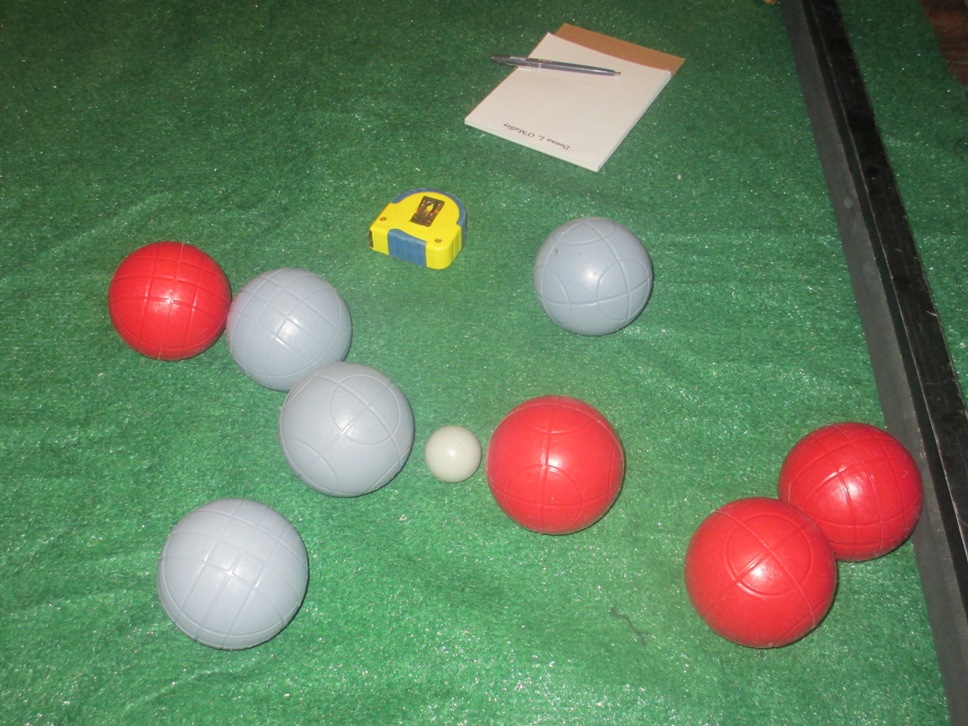
All the equipment you need to play bocce.
Just in case you’re one of those rare folks in South Jersey that doesn’t have Italian roots in your family tree, the rules of bocce can be learned in about ten seconds. Here they are:
1) A target ball, called the pallino, is rolled out onto the court.
2) Two teams take turns rolling balls as close to the pallino as possible.
That’s pretty much it. Oh, there are rule variations; there is an International Bocce Federation that defines regulation court sizes for tournaments and rules about things like what to do if a ball strikes the backboard. Major League Bocce does have its own set of statutes for game situations, obviously. But if a person can grasp those two basic rules, they can play bocce.
A bocce league is like a bowling league. Participants can drink beer while playing, often wear shirts bright enough to direct traffic, and range from every level of skill. But bocce has some key advantages over bowling too…like not having to rent community shoes that are cleansed only with a mysterious spray, for one. Nor is the scoring anywhere near complicated enough to require a computer program; a team gets a point for each ball closer to the pallino than the other team’s closest ball. On to the next round. And after the game, enjoy an adult beverage at the bar.
That simplicity and community is the beauty of it. In just over ten years, the Major League Bocce people have helped make obvious the benefits of a game that has existed for millennia without ever being an Olympic event.

The equipment may be more advanced, but the game remains the same.
For a sport that has never seen a city government hand over billions of taxpayer dollars to build a venue, bocce has some serious staying power.
The first recorded drawings of men throwing balls…well, round rocks, anyway…at targets have been dated as far back as 5200 B.C. in Egypt. Early versions of the game spread through Greece and then Rome in the years of the Roman Empire. The Romans brought coconuts back from Africa for bowling events…arguably the first recorded instance of coconut migration.
In the days before Abner Doubleday, the game of balls enjoyed quite a bit of popularity. Even celebrities of their day like Hippocrates and Galileo were known to sing the game’s praises. There was no restricting factor like social status; anyone with round rocks could play, and so they did.
Much like Elvis, for a time the game was even seen as a threat to society. It had become so popular that nations began to worry that it was weakening their armies…the appeal of throwing balls drew participants away from military exercises like archery practice. Even the Catholic Church frowned on it, citing it as a form of gambling that could interfere with Bingo nights.
But the game was kept alive in Great Britain; there is a legend that Sir Francis Drake once refused to face the Spanish Armada until after a game was finished. Later, Giuseppe Garibaldi, among his many accomplishments unifying Italy, popularized the sport as we know it today. Its growth eventually led to the game being brought to the U.S. by Italian immigrants. The name “bocce” is the plural of the Italian “boccia”, meaning bowl, as a verb.
According to the United States Bocce Federation, there are 25 million bocce enthusiasts in America today. That might be a stretch, but the sport has definitely grown outside of the Italian-American community, the rapidly growing popularity of Major League Bocce being just one example.
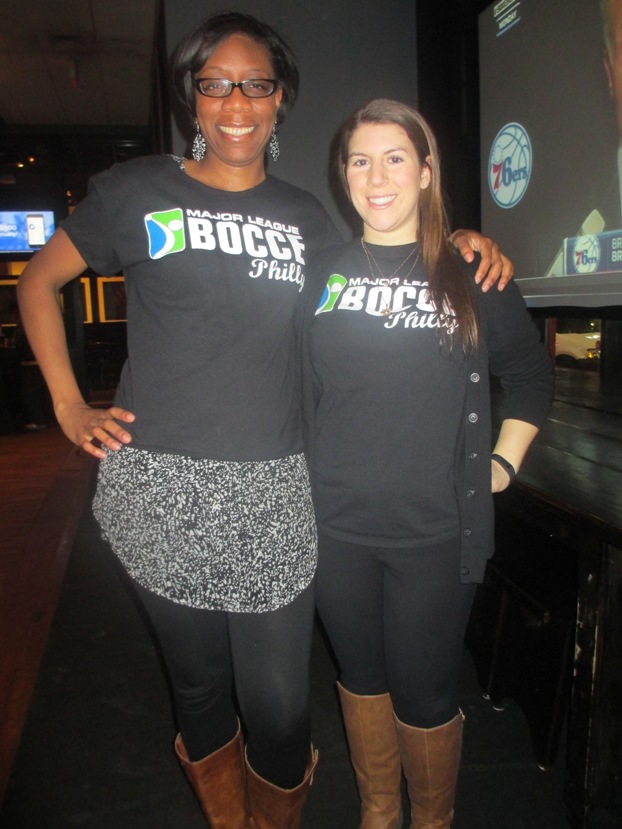
Kamali Brooks and Martine Pelletier, two proud Major League Bocce employees.
From its humble beginnings in a Washington hurricane party, Major League Bocce is now in ten cities; other than D.C., Philadelphia and Boston are where it is growing the fastest. There were 1,500 participants in the Philadelphia division in 2015; Preston estimates that 60% of them are returning customers, a number she is confident will grow even larger. “We’re always testing out different things, trying to see what is the most attractive for people,” Preston says.
That expansion took place in just two years, from 2012 to 2014…“we spent 2015 playing catch up”, Preston laughs…and now there are plans to reach into the West Coast.
Players can sign up anytime; each season of the year features a season of bocce. During the spring and summer in Philly, it’s played outdoors at places like Cavanaugh’s River Deck or in Dilworth Park; in the fall and winter the crew sets up indoors at the Field House or Cavanaugh’s Headhouse in Center City. Each season consists of six weeks of regular season play, followed by two weeks of bracket-style elimination playoffs.
Like the owners say, it’s easy to set up anywhere, and there’s always a place to roll and enjoy an adult beverage afterward with fellow bocce enthusiasts. Drinking establishment partners love the mutual benefit too…simply dedicating a space for a bocce court brings in a dedicated group of customers for eight weeks. Beer brands have gotten into the act as well…Dogfish Head is now a major sponsor with the Philly group, making swag prizes another incentive for players.
And it all happened because some Washington natives take their kickball too seriously.
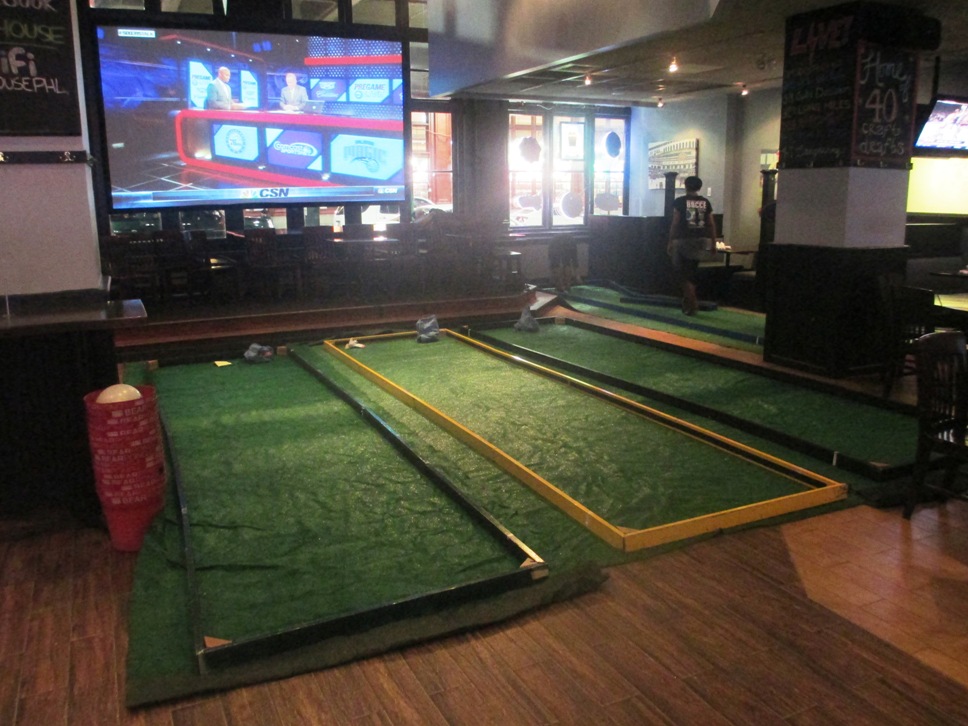
Get your bocce and big screen sports on at the same time!
Preston and DeLucas have quit working for the man and are now full time co-owners of Major League Bocce. It’s been stressful, DeLucas admits, but both are really proud of the growth and success in other cities. It’s doubtful that either of them ever dreamed that finding the ideal fraternizing sport would turn into full time employment. The two have become successful entrepreneurs just through wanting to have a good time with friends.
For centuries, the game of balls has had a way of hooking people like that.
Did this post make your day a little bit?
I hope so. If it did, I would really appreciate your support.
When you use this link to shop on Amazon, you’ll help subsidize this great website…at no extra charge to you.
Thanks very much…come back soon!
Start Your Own Bocce League
Unlike in fantasy sports, where you’re leaving your success in the hands of athletes that have bad days, in a bocce league you have control of your destiny. Major League Bocce enables players with the right amount of “social stamina” to set up their own league. League owners can create a website, post scores and standings, and even activate a system to collect dues. As one league owner stated, “If you can use Facebook, you can run your own league with Major League Bocce.”
The league FAQ lists some tips on setting up your own tournament play, including the equipment you’ll need to set up a court, where to find the best place to play, the number of people in a typical league and a recommended season length. If you need to know more, the folks at the website are glad to help.
And if you’re a bar owner in South Jersey who’d like to bring in some bocce players, give Sarah DeLucas a shout. “I really want to try and get something going in New Jersey; I looked last fall at the Collingswood/Haddon Heights area, but we just weren’t able to get it off the ground. It would be spectacular if someone came to me,” she laughs.
The league website is www.majorleaguebocce.com.
Fanny Kissing Is For Losers
In the 1800s when a version of bocce called “boules” or “petanque” was enjoying popularity in France, the story goes that in addition to the agony of defeat, a woman named Fanny would expose her rear end to the losers, who were then required to kiss her behind.
There are several versions of how the Fanny legend got started. One story goes that she was something of a boules groupie, who let losers kiss her on the cheek as a consolation prize…until the town mayor lost a game. Fanny not being a fan of the mayor, she exposed her rear for him to kiss instead…which he did, as politicians do so well.
Petanque players often use the phrase “being Fanny” for a team that loses a game without scoring a single point. Today there are sculptures or trophies of “Fanny” nearly everywhere that the game of petanque is played, and likenesses of her are often seen in bocce clubs too.

The Greatest.
(photo courtesy Antonio Busso on flickr)
Umberto Granaglia – The Greatest
The late Umberto Granaglia, who passed away in 2008, was widely considered the greatest bocce player ever. It’s hard to argue the numbers: 13 world championships, 12 European championships, and 46 Italian national championships…records all…from 1954 to 1980. He was named “Player of the 20th Century” by the Confédération Mondiale des Sports de Boules, the official governing body of bocce.
The Bocce Federation of Australia’s obituary of Granaglia especially praised his performance in the first ever World Bocce championship held in Australia, in Melbourne. Granaglia led Italy to the doubles championship, soundly defeating France 15-6 in the final. He scored 28 hits in 29 throws in the final game. “A remarkable performance”, the obituary noted.
If you really want to establish your credentials as a bocce enthusiast, get yourself an Umberto Granaglia trading card…you can order one on eBay or Amazon.
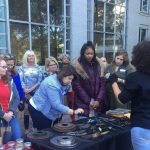
Because She Can – Patrice Banks
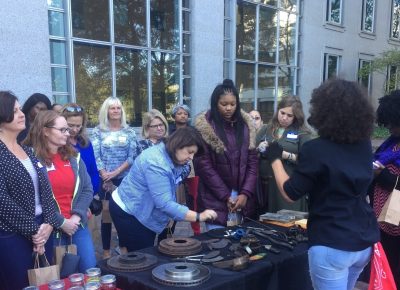
Patrice Banks gave up her six-figure income occupation to start up the Girls Auto Clinic, an auto repair shop run by and for women. Women can get the car fixed and have their nails done while they wait.
This piece appeared in the December 2017 issue of JerseyMan magazine. You can read it on their website here, or click here to see the PDF from that issue.
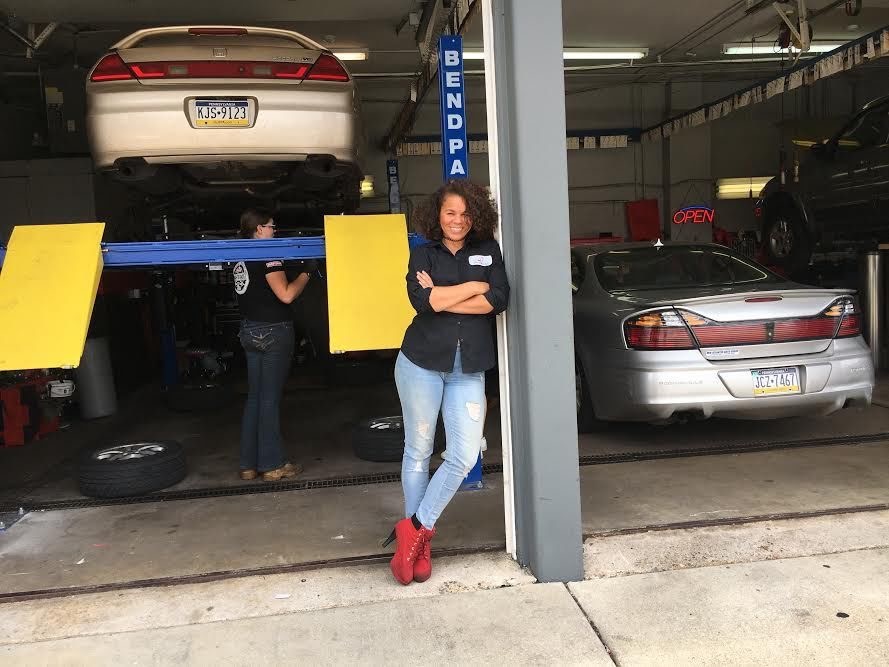
The attractive and savvy Patrice Banks at her auto repair shop.
(Photo courtesy of Patrice Banks)
Because She Can
Patrice Banks, owner of Girls Auto Clinic in Upper Darby, is smashing a conventional wisdom held for generations…that women can’t understand cars.
As we guys know, our women can be astoundingly forgiving sorts. We see it an awful lot with our leaders’ wives. We screw up regularly, and they not only put up with it, they’ll even show support for us in public.
But take advantage of a Philly girl one too many times, and one day she’ll open up an industrial-sized can of whoop-ass on you.
For example, imagine an entire industry neglecting a demographic worth $200 billion a year. That’s how much the fairer sex spends buying automobiles and repairing them. And yet in a 2013 RepairPal survey, two-thirds of them believed they were overcharged for repairs simply because they are women.
Patrice Banks, owner of the Girls Auto Clinic and Clutch Beauty Salon in Upper Darby, knows the feeling. As a former “auto airhead”, she spent much of her adult life dreading—and sometimes dangerously postponing—trips to mechanics for oil changes and repairs. Like much of her gender since the dawn of automobiles, her lack of car knowledge caused her to zone out whenever a mechanic explained a repair. And yes, she has stories about being ripped off.
One day a wormhole opened. Banks suddenly decided to answer a simple question that no one had answered in over a century: Why are females so intimidated by the workings of an automobile?
Answering the question turned into a lifetime mission…to finally answer to the needs of that $200 billion demographic.
At Girls Auto Clinic, women can get their car serviced…and have their nails done as they wait. Nearly all her employees, including the mechanics, are women. The store is popular enough to have a 4.9 rating in 188 Facebook reviews. Banks also hosts popular and free workshops, and maintains a blog on auto repair and maintenance.
She also managed to publish a 300-page book breaking down and explaining cars, titled the Girls Auto Clinic Glove Box Guide. The book openly states that it’s a necessary component of a well-stocked glove compartment. Boastful? Maybe. But in the book, the blog and her workshops, with her simple explanations of why cars need oil changes and what crankshafts do, Banks makes the point throughout: this stuff isn’t that hard. If a former auto airhead can teach it, anyone can learn it.

The former auto airhead is now a teacher.
(photo courtesy of Patrice Banks)
If she only desired financial success, giving up a lucrative career and sinking one’s life savings into an untested business model would be an odd route. It’s female independence that drives Patrice Banks.
As the daughter of a single mother—who, as Banks puts mildly, made poor life choices—she saw first hand the need for women to be self-sufficient.
“I didn’t have an empowered mother, which is crazy, because I was always an empowered girl. I always wanted to prove that women could do anything men could do,” she says. “I believed I was bigger than my surroundings. I didn’t want to become my mother. So I was always funneling my extra time into positive things, schoolwork, sports, having jobs.
“My mom didn’t know how to drive, she took the bus to work. I had to ask people for rides home, and I hated being dependent on others. And that has a lot to do with why I’m very self-reliant.”
In her desire for a better life, she toiled for a degree in Materials Engineering from Lehigh University. From there she spent 12 years as a failure analyst and manager at DuPont, where she was pulling down six figures. In other words, she made enough money to buy new cars solely to minimize trips to a mechanic.
In her spare time, she started a blog called “Banks On It”, dedicated to teaching women to do things they generally paid or asked men to do…such as fixing toilets or investing money. As she mined for ideas, she asked every woman she knew what they needed help with the most.
The overwhelming response? Wait for it…“Cars.”
Banks searched for a female mechanic in the area to help her explain automobiles…and came up empty. It was, she says, her “light bulb moment”. The well-paid engineer decided to become a mechanic herself.
She spent evenings earning an Automotive Technology diploma from Delaware Technical Community College. During that time, she offered to work as a mechanic for free…and was turned down at several shops, for reasons like “the boss’s wife won’t like it.” Once she became familiar with the not-so-complicated inner workings of automobiles, she opened her own shop.
Judging from the exposure she’s gotten since, including appearances on Fox & Friends, CBS This Morning, and O Magazine, it sounds like she’s onto something.
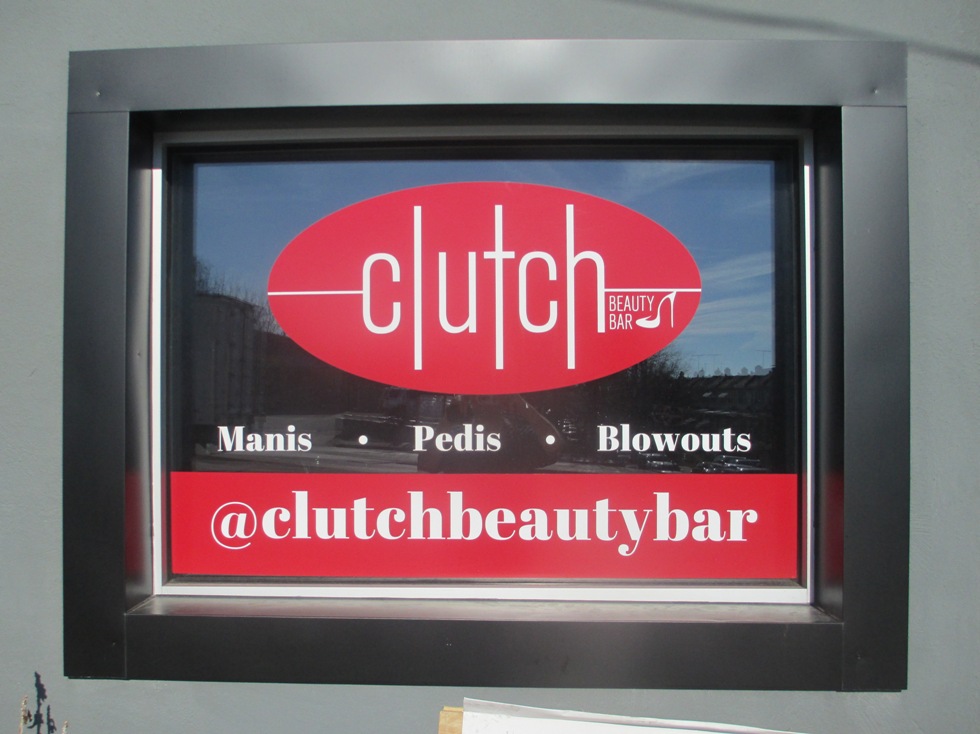
The salon right next door, for hair and nails while you wait.
As Banks wrote in a Washington Post op-ed, 2% of the nation’s auto mechanics are women, and just 13% of car salespeople are women. She drove home the point: “it’s easy for us to feel misunderstood and mistreated by the auto business when we don’t see ourselves reflected in it.”
“We need to have more women in the industry that we can interface with, that we can talk to about our cars,” she says. “Women would rather deal with a woman because we know what they go through. We have women that come from miles away, they don’t even care about our certifications, they trust us to work on their cars because we’re women. That’s how bad it is.”
As an example, she cites unnecessary “upsells” like filters and flushes that shops peddle to less car-savvy customers. “They do need to be done, but they only need to be done at certain times. You don’t need an air filter every oil change, you need one maybe every other oil change.”
She unequivocally states that it’s ingrained. “It’s become this culture, because of the way that the business model is set up. I see people being told they need new brakes when they don’t. I see that all the time. When I went back to school, I realized what’s really necessary. We’re not going to upsell, we’re going to offer you a fair price.”
And if you’re marketing to women, it doesn’t hurt to have a beauty salon as a waiting area. The Clutch Beauty Bar is humorously auto-themed, with toolboxes at each station and a sink constructed from a wheel. It’s a place where women can get “manis, pedis, and blowouts” as their oil is being changed.
The customers love it. As Lorie “Lulu” Tisdell gets her toenails painted, she gushes excitedly about GAC, pointing out the toolboxes and hanging extension cords in the salon and sharing her story about finding the place during a snowstorm. Lulu has been a loyal devotee since the beginning.
Even more so, Banks’s employees are appreciative. As Colleen McClure works the front desk taking calls and speaking with customers, she shares how she worked for years at a hydraulic shop and turned wrenches at other independent repair shops. She offers a simple explanation why she quit: “I was treated like s***.”
It’s an obvious business model. But an industry that spends millions coming up with car names like “Probe” and “Cruze” somehow missed it.

Patrice with her book, an easy, enjoyable read.
(photo courtesy of Patrice Banks)
It’s actually difficult to imagine Patrice Banks having difficulty persuading a man to fix her car. She is easily personable, bubbly but never overbearingly so, and decidedly easy on the eyes.
Away from a camera or microphone, her humility stands out far more than her trademark spunk. She can even be seen decorating a Christmas tree in the shop. “I always look forward to decorating until I’m actually doing it, then I realize this is hard work,” she jokes. When talking with Patrice, one never gets the impression that she considers herself superior.
Which, when you think about it, makes her a perfect fit to appeal to a demographic whose pet peeve is feeling condescended to by mechanics and salesmen.
Ask her what her proudest achievement is and it’s not being featured in Oprah’s magazine or on national TV. It’s her success in what she set out to do…help women in an arena where they have been neglected, and given the amount of money they spend, profoundly underappreciated. There have been difficulties, to be sure, but Patrice Banks has no doubt that this is what she was born to do.
“With any startups, you make a lot of mistakes that cost you a lot of money. Everyone will. I tell people, I fail every day, and I look forward to it, because it gets me closer to winning. Small businesses make dumb mistakes, big businesses make dumb mistakes and it costs them millions. I’d rather make them now when I’m small.”
There is nothing small about the impact Patrice has had on her employees especially. “Since my shop opened, my mechanics have come to me and said this was the best paying job they’ve ever had. And that makes me feel good, to be paying women well, to help their families, particularly in a profession that they’ve struggled in and been kicked out of.
“That to me is my greatest accomplishment, and I’m grateful.”
Did this post make your day a little bit?
I hope so. If it did, I would really appreciate your support.
When you use this link to shop on Amazon, you’ll help subsidize this great website…at no extra charge to you.
Thanks very much…come back soon!
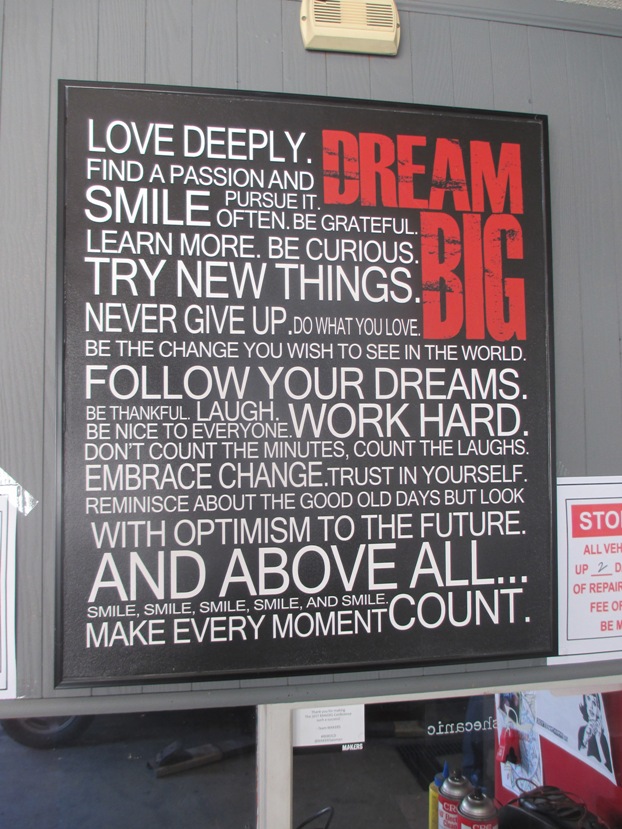
It’s actually all common sense when you think about it.
You Turned Down Who?
Despite that every day she has to ensure that customers keep coming to the shop, Patrice Banks has turned down opportunities for publicity that struggling entrepreneurs would die for. Imagine rejecting offers to appear with Rachael Ray or Ryan Seacrest, or even a chance to show America your business on “Shark Tank”. But she’s learned that national exposure isn’t always a good thing.
“Press isn’t always cracked up to what you think it is,” she explains. “And one of the reasons is that there’s too much content. Everyone’s looking for content. I would be excited at this network coverage, and they would do the story and I would be on TV, but all I have is my shop, I can’t reach someone in California. So it wasn’t translating into sales.
“We were having people come here and shoot all day, five or six hours, but some people would like my page and that was it. I couldn’t convert it into buyers. It started to become a distraction, because I had nothing to sell to a national audience. People would want me to franchise, and I just can’t yet. It wasn’t an advantage, because I wasn’t prepared for it.
“Rachael Ray and Ryan Seacrest, they all wanted to have me on before my book came out. The problem I have now is, now that I have a book to sell, the old press are saying, well, we’ve already done a story on you. And new press is saying, well they did a story on you.
“But you don’t know these things starting out. You’re all like, it’s great, and you can talk about it, but you realize that’s not always the best way to go about it.”

The trademark heels.
What is a #SheCANic?
Part of Patrice Banks’ dedication to helping females is by turning them into “#sheCANics”. The term, in her words, describes “a female of any age who has mastered the mechanics of ‘yes I can’ and uses them to get to ‘yes I did.’
On the #sheCANic page of the Girls Auto Clinic website, women can read a blog full of car tips, find out when and where Patrice will be giving her next workshop, or join a Facebook community of over 9,000 members where they can have their car questions answered.
The blog is full of posts directed at women…with titles like “Alternators Are Like Cell Phone Chargers…” or “Does Your Car Have Boogies?” But they are ultimately serious and simply explained posts designed both to help women take better care of their cars and also to realize that these things are easy to understand.
The #sheCANic logo includes the red heel, a part of Banks’ signature look that happened by accident. “I had to go right from work to school,” she told Oxygen.com. “At work I wore slacks and heels. At school we had to wear dirty clothes, so I mixed them up. One day I was under a car pulling out a starter, and someone took a picture of my heels sticking out. It was perfect.”
Incidentally, no, Patrice doesn’t work on cars with her heels on. Nor, she says in her book, does she recommend doing so.

Northlandz Miniature Wonderland Railroad Museum

Sometimes JerseyMan lets me come up with my own assignments, so I got to visit Northlandz in Flemington, NJ … the Model Train Capital of the World! This article appeared in the Spring 2020 issue of JerseyMan; click here to see the PDF.

Kind of like the railroad version of the I-295/I-76/I-676/NJ-42 interchange.
All Aboard!
The Northlandz Railroad Museum in Flemington was listed in the Guinness Book of World Records as the world’s largest model railroad. Bruce Williams Zaccagnino’s creation is now the beneficiary of new ownership, an expensive makeover, and finally, the marketing respect it richly deserves.
Julie Parker’s occupation was to tell people about businesses worth visiting in Flemington.
And she had never heard of Northlandz.
That’s roughly the equivalent of being in charge of Philadelphia tourism, and not being aware of Independence Hall, the Liberty Bell, the Art Museum, and the Reading Terminal Market.
It wasn’t Parker’s fault, though. The genius behind Northlandz is an excessively modest man, who cared more about creating his art than promoting it.
She fondly remembers meeting him.
“I was doing the Flemington Information Center. Somebody told me, you’ve got to go see Bruce Williams, he just opened this place called Northlandz. I said, okay, maybe I can promote him. I had a group of businesses that would pay me and I would promote them all over Flemington.
“He actually had me go through it, and I came out and I looked at him and I said, ‘Oh my God, you built this whole place yourself?’”

This is about 1/100th of Northlandz.
If that story is remarkable, it gets better. This phenomenal exhibit of a hobby taken to an unimaginable extreme was almost decimated.
Thankfully, the building fell into the right hands…businessmen with more enthusiasm for putting smiles on faces than for profit.
Tariq Sohail, one of the new owners, was equally shocked and amazed in his first visit to Northlandz. He was minding his own business looking for a storage warehouse, and came upon a large gray building off Route 202 that might work.
“We drove past it so many times. I never knew what it was. Our real estate guy said, if you don’t like what’s inside, you can always demolish it.”
As Sohail describes his reaction to seeing what was inside, Parker chuckles, as if fully appreciating the astonishment factor.
“We started going through the whole tour,” Sohail continues. “We were like, in our lifetime, nobody has ever built something like this. We’ve traveled throughout the world, we’ve never seen anything like this.
“So we decided to take a risk and invest into it and promote it.”
That they’ve done. Northlandz needed work, to be sure…read reviews from a few years ago and you’ll see a lot about the state of disrepair it was in. Sohail and his partners have thus far poured several hundred thousand dollars into cleaning it up, and the results are nothing short of remarkable.
“There are people that came three or four years ago and they say, we can’t believe the difference,” Parker says proudly.
The new ownership has a larger vision for Northlandz too…it includes shuttle buses from New York City, a hotel, a banquet hall, and much more. All revolving around a toy train set.
That said, it is one truly amazeballs train set.

People like to live dangerously here.
Northlandz is, simply put for brevity, the world’s largest model railroad, according to the Guinness folks who are experts on such things. It spans over 45,000 square feet and 16 acres. The walkway just to go through it is over a mile.
To give you an idea of just how staggering its size, this observer had taken over a hundred pictures before reaching a sign that reads: “You are now 25% through Northlandz”.
Every moment is sheer model railroad wonderment. Huge displays filled with mountains and bridges, offering backdrops to bucolic still life of homes, factories, rivers, and neighborhoods. There’s “Iron Valley”, with its multiple iron bridges gracefully leading through mountain tunnels. There’s “Joycetown”, with churches, homes, and model trucks decorated with staples of American commerce like Kodak, Dollar Tree and Valvoline. There’s a fully detailed city mockup featuring an aircraft carrier. And a display of mountain life with busy railroads throughout that literally occupies three floors of the building. Tunnels? Northlandz features over four hundred of them.
On and on and on.

Like a scene from The Fugitive, isn’t it?
Any one of these displays could be the highlight of nearly any museum in the country. You could literally spend hours in one spot, watching a toy locomotive charmingly meander through a perfectly scaled-down neighborhood.
And this marvel was nearly all built by just one person.
Sohail estimates that Zaccagnino spent 17-19 hours daily, seven days a week, for close to four years building a miniature world. As one can imagine, he received little to no support from family members…as if spending eight hours a day and five days a week in a cubicle somehow makes more sense. According to Sohail, only Bruce’s wife Jean always supported the venture.
You could probably be forgiven for thinking your neighbor was crazy for devoting even sleeping hours to building a model railroad.
Then you see the finished work, and you realize crazy people are awesome.
“You won’t believe your eyes” is Northlandz’s slogan, and despite seeing it every day…Parker is currently the Northlandz Marketing and PR Director…she repeats those words herself often, with genuine passion that every employee shares.
“I just feel it’s magical,” she gushes. “How can somebody have conceived this? It’s incredible. You go through it and you start seeing all these little trains going in the little villages and the different themes and the different venues.”
“Everything is built by hand,” Sohail adds. “He told us one of the bridges that he built is 40 foot long, 23,000 small wood pieces, that he put together one by one by one by hand.”

Yes, I would go to church before crossing that bridge too…
Ask anyone working at Northlandz what the appeal of a huge model train set is and you’ll get a different answer.
Parker thinks it’s the glimpse of history.
“I think it goes back to the industrial revolution. Trains made our country great. They transported everything. Food, industry, it’s like the backbone of our economy. Buses, trains and cars, they’re what makes the economy tick.”
Sohail believes the appeal reaches us on multiple levels. He refers to young people who come to work at Northlandz and help with the layouts out of pure passion.
“Within the train layout, you have to have more than one skill. It’s architecture, it’s engineering, it’s electrical, it’s design, it’s scenery. Basically doing one hobby, you’re learning all different skills.”
Ken Vogel, a train technician, generously took time to point out multiple intricacies of Northlandz during this interview. He remembers his own days of building model trains, and bringing one of his fellow hobbyists to Northlandz for the first time.
“Bruce signed a box car that we brought here from my nephew. What I said to him at that time was, I know a lot of people that are remodelers who always wanted to build an empire and never did it. I said, you’re the only one that did.”

Who knew miniature life could be so much fun?
Sohail thinks the moving train gives life to a piece of art. “You’re looking at something beautiful going up and down, and all of a sudden the train comes.”
Worth putting over $300,000 into preserving? No question for Sohail. “Every time I come, it excites me as well, even when I own it. I see the people coming out of the place and I see how big the smiles on their faces and how happy they are to see it.
“That’s made me happy.”
Walking through the magical railroad empire that is Northlandz, one gets a sense of needing to be of advanced age to fully appreciate the endeavor. The longer you’ve spent on Planet Earth, the longer you’ve gone without witnessing anything like it.
But even this observer’s little ones can’t wait to go back.
Did this post make your day a little bit?
I hope so. If it did, I would really appreciate your support.
When you use this link to shop on Amazon, you’ll help subsidize this great website…at no extra charge to you.
Thanks very much…come back soon!

Isn’t “largest miniature railroad” like “light heavyweight”?
If You Go (And You Should)
If you are at least enough of a model train enthusiast to, say, put a little track under your Christmas tree each year, you have to visit Northlandz. In most any search for “largest model railroad in the world” or “largest model train display”, you will find Northlandz in the list.
The most important piece of advice for going is this: devote an entire day to your visit, whether you’re bringing the grandkids or not. You may be able to enjoy all of the exhibits in an hour, or you may want to take more time to fully appreciate the astonishing level of detail…and that can truly take a full afternoon.
There is a kids play area in the middle of the museum, which features an organ that Zaccagnino would play for visitors from time to time. Zaccagnino is retired now, but there is still enough to give the little ones a break before they see the rest of the museum.
You can find a few complaints online that Northlandz is on the pricey side, although it’s well worth every penny in this observer’s opinion. That said, there are online coupons to take a few bucks off of the price…just search for “Northlandz coupon”. Military, teachers and seniors get discounts, and persons with disabilities get in for free.
It’s easy to get to Northlandz in less than an hour or so from the Philly area, but should you need to spend the night, there is a Travel Inn & Suites just steps away down the road, and a Hampton Inn a bit further away in the heart of the shopping area of Flemington. The Hampton tends to get better reviews.
If you’re hungry there’s McDonald’s, Chick-Fil-A, and multiple other restaurants where U.S. 202 meets NJ-31 just a short drive away.
One last thing…if you take the kids, they’re going to want to go back. Not that you’ll mind.
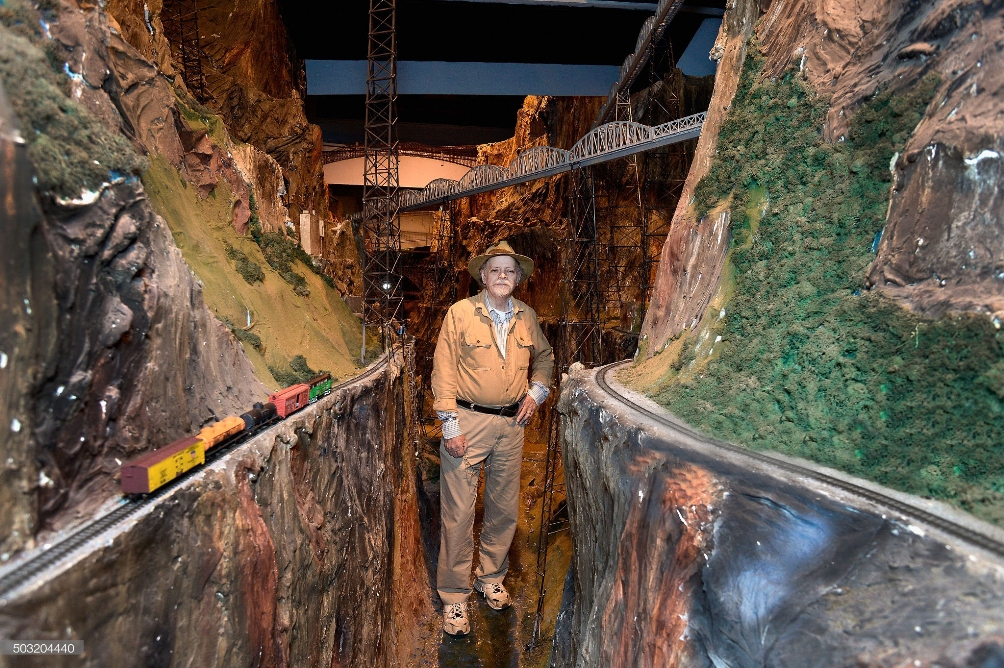
The genius behind it all. (Photo by Paul Marotta/Getty Images)
The Man Who Built It
Bruce Williams Zaccagnino got started in the same place most all model railroad enthusiasts do: in his basement. More correctly, in a basement of a house that was being constructed, according to the Northlandz website. The construction workers would leave for the day, and he would build mountains and tracks in his new basement.
Like today, nearly everyone who saw his work was quite impressed, to the point where he would open it for the public on weekends. He purchased the land on Route 202 as the popularity grew, and the rest is history.
Zaccagnino was no stranger to artistry, incidentally. He made a decent amount of money in the video game industry, including winning several awards as a developer/designer. He was, according to Sohail, quite the accomplished musician as well. “I watched him play the organs that we have over here. I never saw anybody play that well.”
But Northlandz was his passion, obviously. To the point where he spent his time building his dream, rather than marketing it. Sohail compliments his modesty, but expresses regret that his people didn’t meet him sooner.
“We would have promoted this throughout the world,” he says.
“He’s been interviewed with CNN and Fox, all the major, you know, and he never made a big deal out of that. He’s in the Guinness world records, this place, and he never even promoted that fact. We saw the certificate, it’s sitting on the exhibit and anybody could take it.”
“Bruce didn’t really advertise; he let itself advertise,” says Ken Vogel. “The point was, it was a guy who had a dream about building a great layout and actually pulled it off. The dream is accomplished.”
Zaccagnino is retired now…traveling, according to Julie Parker, so one guesses he’s actually riding trains instead of building them. But he’s appreciative that his art is going to live on.
“I think he was starting to see that a lot of stuff was falling apart,” Sohail reflects. “He had a feeling like if somebody doesn’t save it, it’s going to go away. When we bought it and we started repairing it and cleaning up and everything, he was very happy, you know, my art is being preserved.
“He said, this is my gift to the world.”

Expanding His Roots – Jeff Holman, Haddonfield High Tennis
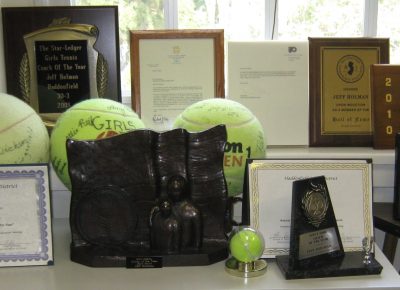
Jeff Holman is a member of the Holman family, a name you’ve heard if you’ve ever shopped for a car in South Jersey. But he’s made his mark coaching high school tennis, with over 2,000 victories to his credit. I interviewed him for the October 2013 issue of JerseyMan. You can view the PDF of this article here.
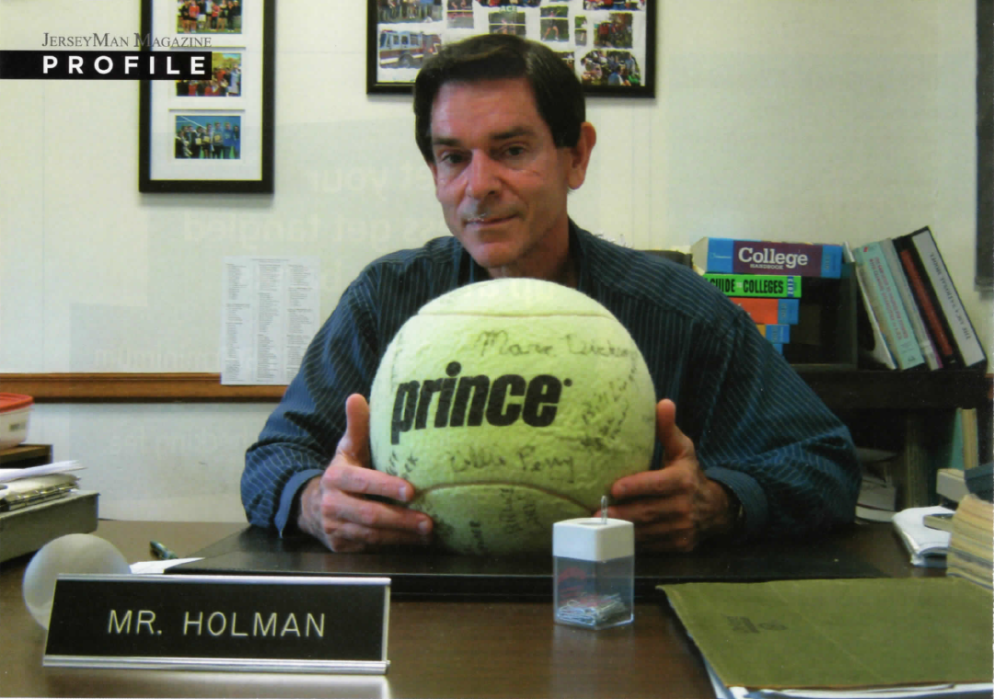
Jeff Holman, the legendary tennis coach at Haddonfield High.
Expanding His Roots
Jeff Holman is a member of the Holman car sales family, but he’s made his own mark in high school tennis coaching.
Mention the name “Holman” to a South Jersey native and chances are a car dealership will come to mind. The name has been selling automobiles in the Garden State for nearly as long as automobiles have existed. Most readers of this publication have probably either bought a car from a Holman or know someone who has.
But over the last three and a half decades, Jeff Holman has achieved what could be called legendary status in a realm that has nothing to do with Cadillacs.
By the time you read this article, Holman, who coaches both girls and boys tennis at Haddonfield High School, will likely have passed an astonishing 2,000 victories—both teams are within striking distance of 1,000 wins each. The boys’ teams have won nine state group championships; the girls’ team has won 18 state group titles and three Tournament of Championship crowns—often against larger schools with bigger talent pools.
He’s gotten quite a bit of recognition himself; 20 Coach of the Year awards, and membership in five Halls of Fame, including Camden County Athletics and the New Jersey High School Hall of Fame, are a small sampling of the countless awards and honors he’s received.
As successful as the family is in car sales, Jeff has proven that the Holmans aren’t a one-trick pony.
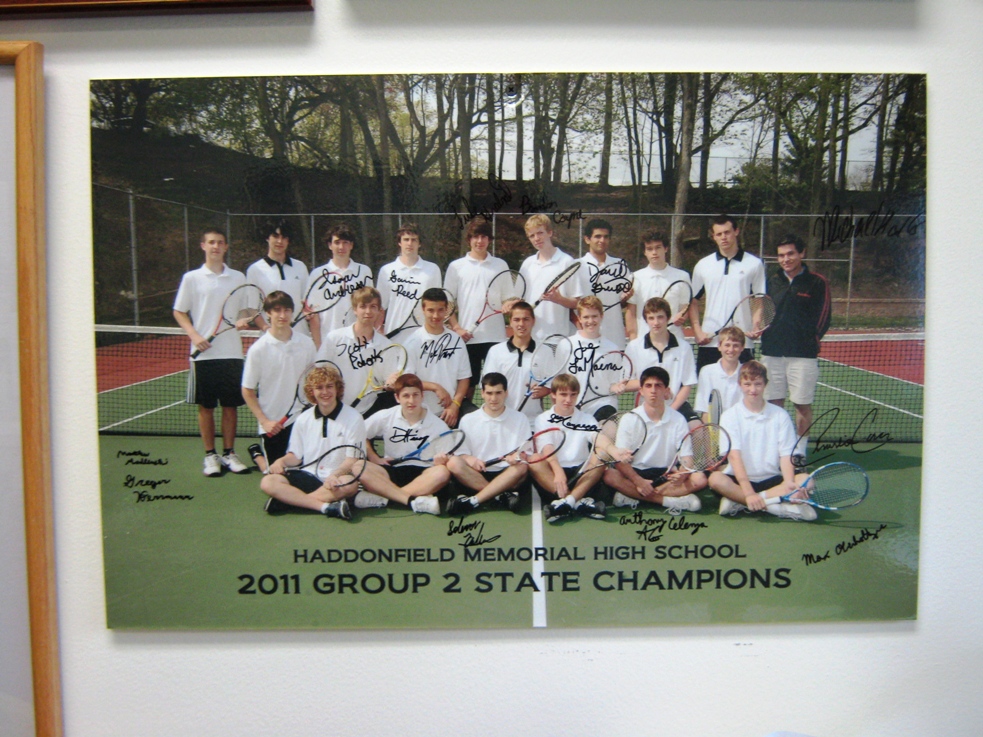
The Group 2 2011 Champions.
As a young lad, Holman probably thought he would sell cars when he grew up. He once wrote a “future career” paper on being a car dealer, which given his background was probably an easy assignment. But he says no undue expectations were placed on him by his Jersey famous family.
“I have two siblings; my sister Mindy is now the CEO of Holman Enterprises, and my brother Steve is a cabinet maker in Dorset, Vermont. Mostly, my parents encouraged me to do what I wanted to do. I had good teachers that encouraged me to get into education.”
Holman was a decent player at Haddonfield High, known for not rushing the net and simply wearing opponents down. But he knew he wasn’t destined for stardom on the court either. He attended college at Princeton, where the talent was, to put it mildly, substantial.
“The #1 varsity player at Princeton (Bill Colson) was ranked ahead of Jimmy Connors. My roommate was a two time Nebraska state champion; he wasn’t even a consistent starter. I was realistic enough, a good high school player, but I never thought I could play professionally.”
After graduating from Princeton, Holman returned to Haddonfield as an English teacher, and served as an assistant coach on the girls’ basketball team. Haddonfield being a small school, there weren’t enough tennis courts for two teams, so the girls’ season was moved to the fall in 1976. Their coach, Ellie Kind, was also the field hockey coach, so Holman took over the tennis team when the two schedules merged.
Two years later, Ken Grabert, the boys’ coach, “decided that driving the bus to events paid more than coaching, which was correct”, and Holman took over the boys’ team. 35 years later, though he’s now a guidance counselor, he is still on the court with young people most afternoons, steadily adding to the impressive win totals and titles.
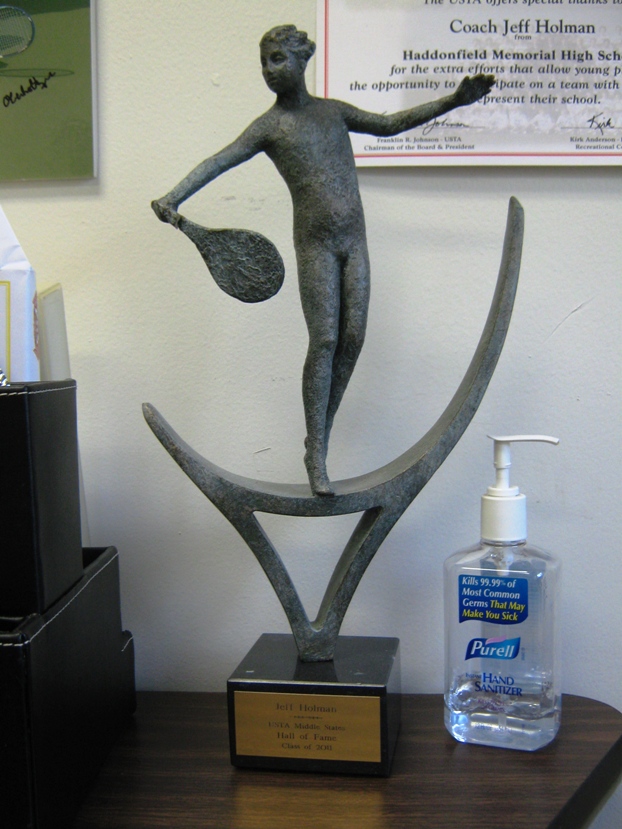
One of many awards found in Jeff Holman’s office.
Leaders in any endeavor will often tell you that success depends on choosing the right personnel. In high school sports, this presents a significant obstacle. Coaches don’t have the option of recruiting the best players from a 500-mile radius. The kids in town are what they’ve got.
In this environment, Holman magnanimously gives some credit for his success to local tennis clubs as a place where parents teach the game to kids. But he also piled another challenge on top of recruitment limitations: a no-cut rule. Every student who signs up will have a chance to represent Haddonfield tennis. Jeff explains the reasoning:
“One of the best players I ever had was a girl named Phoebe Figland, she was part of the 1980 team that won the first ever Tournament of Champions. Back then we had four courts, I had to keep 16 girls, and Phoebe as a freshman was number 17 so I had to cut her. Luckily she wasn’t one of those kids that gets discouraged easily; she came back and earned a starting varsity position, and went on to become a Division I player at the University of Richmond.
“Maybe in Phoebe’s case it gave her more inspiration to become as good as she did. But I think other people might have quit. Since that time I’ve always looked for a way to keep everyone involved and not cut people.”
That means arranging more matches with more teams, which Holman does. “In our program we have 40-50 players, and schools we play against may have 10-15. So by having a lot of matches and a separate rotation system, even though our team is bigger, all of the players get to play in matches. If they are all involved and can have a fun experience and see improvement, they’ll want to keep on playing and getting better.”
If you’re looking to ferret out a nugget from him about how to successfully coach high school sports, that is mostly what Holman will tell you. Keep all the kids involved, having fun, and playing tough competition. Encouragement and positive reinforcement. Not much about fundamentals.
“The mechanics, a lot of that is learned in the offseason. It’s hard to change someone’s mechanics during the season. They might get worse before they get better. There are outstanding professionals in the area that our students have gone to, and these teachers have instilled some mechanical knowledge of the game.”
So instead of teaching backhands or “getting into the zone”, Holman’s focus is on arranging as many matches as he can with quality opponents, and separating practices into groups so that all of the players get time in with the coach.
He even drives the team bus. It’s a gesture that appears to be a show of humility or bonding, but it is actually rooted in practicality: “If the school doesn’t have to pay a driver, then tennis, which has no transportation costs, enables Haddonfield to play an ambitious schedule. We can go to North Jersey or I can schedule more matches in a week. In this era of budget constraints, not having to play a bus driver really frees up our program.”
Whatever it takes. “I think it’s important to convey that this team is very important to me and I’m going to work harder than anyone else. And that whatever I ask the players to do, I’m going to do the same thing or more in terms of commitment.”
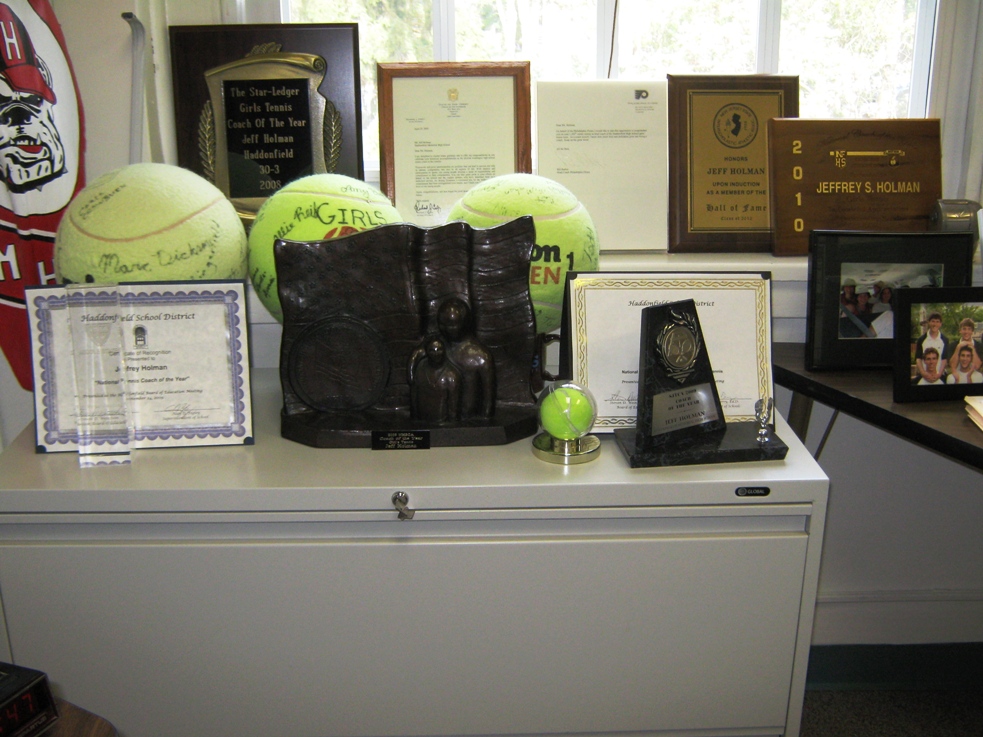
So many awards it almost blocks the window.
Holman’s proudest achievement? After coaching 70-plus seasons, he has trouble picking a favorite memory. “I guess when you do something the first time it stands out. On the girls’ side I think back to a team in 1980, the first year New Jersey held the Tournament of Champions, when the state champions of all the different divisions have a playoff. The 1980 team won that initial tournament. The boys kept falling short in state tournaments; finally in 1983 that group of players was the first Haddonfield team that won a state title.
“Haddonfield has always been a very successful athletic school at everything, but there have only been a couple of teams that have won a Tournament of Champions. The girls’ tennis team has done it three times now. It’s a very rare achievement.”
Holman tempers any appearance of boasting. “It’s nice to win championships, and we’ve done our share of that, but above all we’re trying to instill a love of the sport, and in their later lives they are still playing, and that maybe part of the reason was the Haddonfield program.”
One of the winningest high school sports coaches in the country seems reluctant to suggest that what he does results in more than young people enjoying the game of tennis. But he’s undoubtedly played a role in the character building of many young people. To teach them that they will have a chance to get in the game, to play against the best, and to be able to challenge opponents with unfair advantages and still win, undoubtedly leaves a stamp of confidence on an adolescent mind where self-esteem can often be in short supply.
Especially for a kid that might not have otherwise made a team of 16.
Jeff Holman doesn’t have an apparent personality for car sales. He is a soft spoken, even-keeled fellow, highly regarded by all who know him, but there is still a cauldron of quiet determination in him. If it weren’t for Haddonfield’s reputation as a high school tennis powerhouse, you wouldn’t expect this quiet gentleman to bring a team from a small school that can whip your big school’s behind.
And for several generations of Haddonfield tennis playing alumni, the Holman name means something more than an established place to buy a nice automobile.

The Old Ball Game – SJ Men’s Senior Baseball League
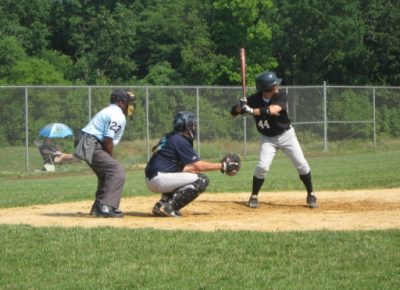
The South Jersey Men’s Senior Baseball League is a haven for men in their advanced years who still can and want to play some baseball. I wrote this piece for the August 2012 issue of JerseyMan; you can view the PDF from the magazine here.
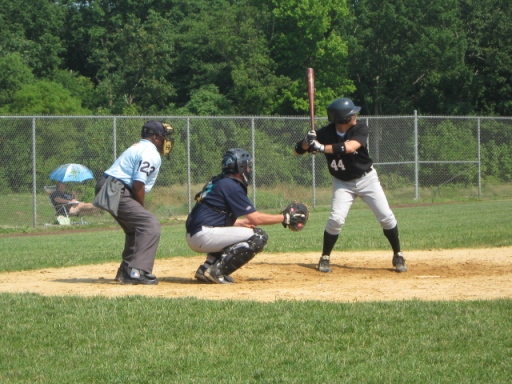
Waiting on the high hard one, adjusting for everything else.
The Old Ball Game
After 20 years, the South Jersey Men’s Senior Baseball League is stronger than ever.
On a picture-perfect Sunday morning at Doc Cramer Field in Manahawkin, the Hammonton Black Sox are playing hooky from church to play baseball, in a time-honored tradition that a Benevolent Supreme Being isn’t likely to mind.
With his team shorthanded, manager Mike Dunleavy must take the field and has enough to keep him busy, so he lets this observer keep score in their game against the Ocean Pirates. At one point a Sox player slaps a weak chop that travels about ten feet but successfully moves the runner on first over to second. There is a dispute over whether it counts as a sacrifice. “You’d be surprised at how much these guys look at their stats,” Dunleavy tells a writer who, as a former softball player, is sure he wouldn’t be surprised at all.
The team has several batters hitting over .400, but they’ve managed little offense in this game. “Junkballers,” the manager says, of his hitters’ performance against the Pirates’ Jeff Martin. “We always have trouble with them.”
In the bottom of the ninth, he calls a conference on the mound with his pitcher Tom King, to figure out how to pitch the Pirates’ Eddie Titley with a runner on second and the game tied. Over King’s objections, Dunleavy orders Titley to be put on intentionally. King, who has pitched a fine game, walks the next two batters, and the Pirates take a 3-2 victory over the Black Sox with two runs in the ninth. Despite its painful obviousness, the manager feels compelled to point it out: “Tough loss.”
Following the game there is a brief shouting match in the dugout between Dunleavy and King over the decision to walk Titley, which is fairly quickly smoothed over. It’s not a contract year, after all.
“From eight to eighty, the game is the same,” Dunleavy says. “It’s still about pitching and defense. There’s nothing I can tell these guys that they don’t already know.”
And so it goes in the senior fast pitch baseball world.
Dunleavy has managed Hammonton’s team in the 45+ American Division for seven years. When his team is shorthanded he will take the field, and occasionally he takes the mound to pitch. At his advanced age, he isn’t stealing bases or hitting bombs or overpowering hitters, but like most pitchers he can still pitch a successful game if he keeps the ball down. The Pirates, he says, are their friendly arch rivals—the Black Sox had lost to them two years before in the championship game, and had beaten them last year for the championship. It’s not Yankees-Red Sox, but it still fires up both teams.

Taking the field in Camden for the All-Star contest.
On July 15 of this year, the South Jersey Men’s Senior Baseball League celebrated its 20th anniversary at Campbell’s Field in Camden. In a brief on-field ceremony, league president Lou Marshall and vice president Neil Hourahan presented league founder Bill Curzie with a plaque, as a thank you for being the indefatigable spark for the SJMSBL and a key ingredient of the glue that has held the league together for 20 years. Whether it is attributable to the league’s success is not certain, but Curzie does not appear to have aged at all in two decades, and at 77 still looks fit enough to play two.
In 1992, at the age of 57, Curzie met up with players of a Pennsylvania division of the MSBL, and asked about setting up a fast pitch baseball league in South Jersey, which had none at the time. National league president Steve Sigler enthusiastically gave Curzie permission, and off he went.
With the help of a story in the Burlington County Times—that began with the words “Curzie is serious”—Curzie spread the word quickly. It turned out that South Jersey was heavily populated with thirty-, forty-, fifty- and even sixty-somethings who still wanted to play ball—and didn’t mind faster pitches or nine innings, the way the game was meant to be played. In less time than it takes a superstar free agent to say “it’s not about the money”, there were enough players for four teams, and the league began with six.
With the help of Curzie’s equally dedicated assistant commissioner Gary Brown, the SJMSBL kept growing, and is now the second largest senior fast pitch league in the nation, with over 1,200 players in four age brackets. There’s been a 25% growth in the 18-year-old group, which bodes well for the long term health of the league. They are adding a 55+ division next season.
Curzie shares the story of his standing firm on the league moving to wooden bats, after the national disgrace of aluminum bats had been the norm for some years in nearly every league. Today, most fast pitch leagues are back to using wooden bats, and Curzie humbly accepts some of the credit for that. When asked the ridiculous question of why wooden bats over aluminum, he has a simple response: “It’s just baseball, man!” He does elaborate further, though. With the reflexes of players at this age, aluminum bats are more dangerous, and besides, there are too many cheap hits with aluminum.
Today Marshall and Hourahan now handle the running of the league. The list of administrative tasks is long. In the beginning of the season, Marshall must be in continuous contact with the national headquarters of the MSBL, ensure that fees are collected, manage schedule changes, work with the umpires’ organization, deal with the inevitable problems that teams will have with the schedule, and arrange the All-Star weekend in Camden.
It’s a lot of work maintaining the league and playing on top of it—a full time job, Marshall admits. It’s all worth it, of course. He echoes the sentiment of the players on the field: “you feel like you’re eight again.”
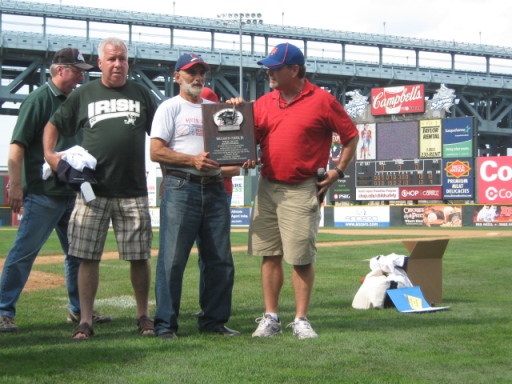
Bill Curzie accepts an award for putting players back on the field again.
There aren’t hot dogs, exploding scoreboards or the roar of the crowds. You won’t see players at the level of Andrew McCutchen or Mark Teixeira here. But you might appreciate, as these fellows do, how difficult it really is to throw out a baserunner attempting to steal or to turn a double play. Dunleavy says, “Hunter Pence can throw out a guy at third base. We would need a couple of extra throws to get the ball there.”
Perhaps, but that’s an exaggeration that doesn’t give credit to the skills many of these fellows have.
They wear uniforms and cleats. They steal bases. They take advantage of fundamental mistakes. They throw the ball around the horn after a strikeout. They use leg braces and pine tar. Balks and infield flies are called. There are rundowns, pickoffs, and lots of spitting. There is pressure to win, real trophies, and real statistics displayed online that people from here to Cambodia can see.
Some players even look for that little bit of rule-bending edge. Marshall tells the story of a pitcher loading a ball with tobacco juice and snot; eventually he even bought a container of K-Y at the store with his wife present—assuring her it was for his “other slider”.
Being an umpire, which pays in the neighborhood of $80 a game, is just as thankless a job as it is at any level of baseball. Players gripe about calls throughout the game, which the ump, who wants to appear professional just as the players do, mostly takes in stride. Between innings an umpire shares stories about rare times where he’s ejected players. One involved a thrown bat making a loud clang; another involved foul language directed at him. But most times, he says, if he’s got to be out in the heat, then so do they.
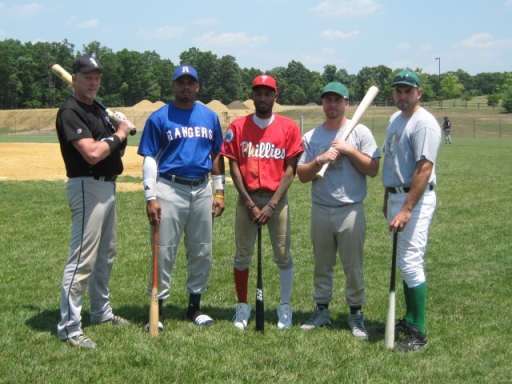
Stars of the league.
The SJMSBL is a haven for men refusing to age—who desire to compete on the highest level they can, relive the playing days of their youth, and many times to do both.
Anyone can sign up and play. It’s a time commitment; players give up a day of their week, in this case a Sunday morning. They’ll need legs too; they’re going to be running the full 90 feet between the bases. Some of them will get hurt in battle; many of the Black Sox’s best are currently on the DL. During the interview, Marshall—who still plays while running the league—shows me elbow scabs from sliding.
Never once does it occur to any of them that none of the games will be on television, that they won’t be driving a Porsche with their contract, or that it’s highly unlikely anyone besides an insurance company will ask for their signature. They are playing a boy’s game again, and loving every second of it. Who wouldn’t leave it all on the field?
Dunleavy remarks: “I have seen in the faces of the older guys what men’s senior baseball has done for their spirit. They never thought that they would ever get the chance to actually suit up and play competitively again.”
From eight to eighty, the love of the game is the same too.

The Life of A Jockey – Jose Ferrer

Being a jockey is tough work. You have to stay in shape, find work where you can, and win enough to keep getting hired. JerseyMan sent me to interview Jose Ferrer, who spent the day riding a couple of horses to victory at Monmouth Park. You can read the PDF of the article here.

Jockey Jose Ferrer, on Fiesta Rose shortly before a win.
Taking The Reins
A day in the life of a jockey.
It’s Opening Day at the Monmouth Park racetrack.
It is cloudy, almost foggy, and unseasonably cool for May. But the chill is of no consequence to those in attendance. When it comes to Jersey weather, “unseasonably” is an adjective that most residents laugh at anyway, and so turnout is still high.
The picnic areas of the venerable venue are full of dining patrons awaiting the next race. Some have brought sandwiches, others partake of pizza or hot dogs at the concession stands. The odor of charcoal wafts from the private party areas. It’s mostly adults in attendance, but there are a few kids, who spend the day looking for ways to amuse themselves.
The infield scoreboard shows a replay of the tight matchup in the previous race, where Mello Groove edged Greed Is Good in a photo finish. Tractors smooth out the track for the next race. A truck pulls the gate along the surface to the starting line.
For the third event, jockey Jose Ferrer, who rode Greed Is Good previously, mounts Fiesta Rose, a three-year-old 9-5 shot. Periodically the announcer reminds the audience how much time they have left to place a wager. Finally after growing anticipation, especially for those with a financial interest in the outcome, the bell rings and eight very large animals begin sprinting out of the gate.
Fiesta Rose starts on the inside of the track and takes an early lead of about a length, which lasts until they turn into the far corner. Halfway through the race, the lead over The Slipper Fits becomes two and a half lengths, with Fiesta Rose gradually building on the lead.
As they round the final turn, it’s clear that this race will be no contest. Over the last hundred yards, Ferrer and his faithful steed have pulled away from the field. Ferrer methodically and rhythmically cracks the whip the rest of the way, just enough to keep the galloping animal honest.
It’s an easy win for Ferrer, and he rides to the winner’s circle with the confident smile of a man who’s been there before. He tosses the whip to a fan with a satisfied flair, raises his arm in triumph, and hops off of Fiesta Rose. He pats his mount affectionately, and starts back to prepare for the next race of the 12-race card. Along the way, he pauses to shake hands with some happy and newly richer fans and to pose for photos with his family.
Ferrer will race several more times on this Opening Day, including piloting a 13-1 shot named Light’s Gone Wild to another nearly uncontested victory in the sixth event. Like with any great athletic feat, the best make it look so easy.
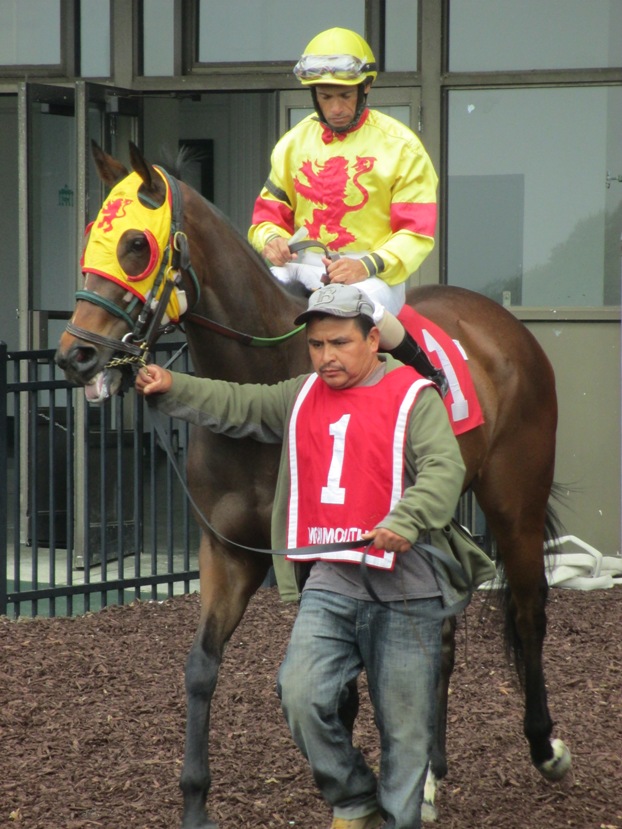
On Fiesta Rose pre-race: “You have to have the horse.”
“You have to have the horse,” Ferrer explains, modestly downplaying his skills. “You’re driving a Corvette, I’m driving a Volkswagen, who’s gonna win? I would say that it’s 85-90% horse, and 10-15% of it is jockey. It could be any kind of odds, 20-1, 40-1, you just need a horse.”
He speaks from experience, this veteran who has been riding horses now for 32 years. With an uncle and four cousins as riders in his family, the occupation is in his blood, and more importantly, he respects the challenge of making a living at it. Like the folks who wait in line to wager on the event, jockeys are rewarded for the horse’s finish. But the jockey has to work harder for it.
“It’s not easy, like people think. Some riders make a pretty good living, but you’ve got to get lucky. We get paid by mount, by horse. We don’t sign a contract, so we’ve gotta go there and compete against everybody. You’ve got to compete, you’ve gotta beat them. You do everything you can to bring the horse to the winner’s circle.”
Ferrer frequently compares the jockey’s life to that of other athletes. Like in other sports, the competition is fierce, the effort can be dangerous, and the best performers seem to have a natural gift.
But being a jockey has its own unique challenges, too. If you sometimes yearn for the blue collar days of athletes past, when even the best supported their families with championship bonuses, listen to Ferrer discuss the jockey’s world:
“If the card has twelve races, you could run twelve races, or you could run one, or two. It all depends on how much business you’ve got. We used to race like five or six days a week, now we race only three days a week. There are a lot of places, Parx, National, that on days off…we call Monday through Thursday days off…you can go ride over there.
“We don’t have a contract or anything; we’re like painters or plumbers. And it’s like any kind of business, if you get a good reputation, you do a pretty good job or whatever, people will call you. The more races you win, the more they want you. It’s about performance, how you perform out there. Any kind of thing could put you on the bench.
“But it’s a cool job, you get to meet a lot of people, it’s great to be on a big horse, it’s a big high, you know. It’s like hitting home runs, to see that you came first, your horse performed great. And if people win money, they’re happy with you, if they don’t they’ll boo you and call you names,” Ferrer says with a chuckle.
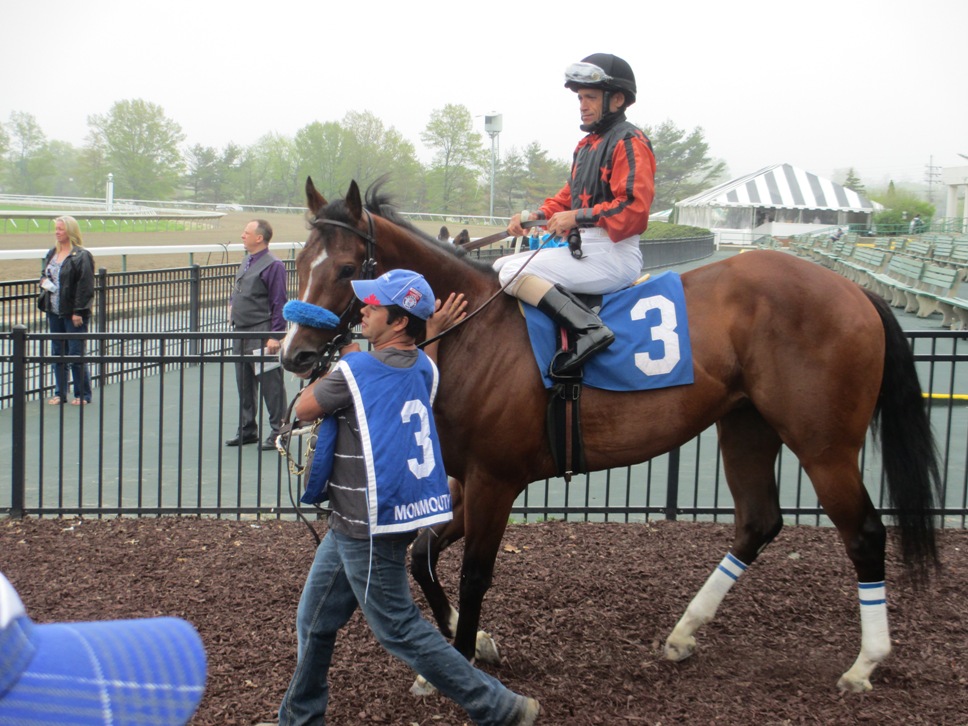
Ferrer on Light’s Gone Wild, another horse he would soon ride to a win.
Asked what makes a jockey skilled enough to be in such demand, Ferrer credits experience and preparation.
“Before the race you’ve got to study the horse. I try to have a good idea what’s gonna happen that race, and then figure out what our position is going to be. There’s a lot of things going on out there. You’ve got to feel the pace. If the horse comes from behind, you lay off. Some horses like to come from last, they break out of the gate and sit back, get comfortable gaining their strength, and then make a move. A lot of horses don’t like to be inside. So you break out of the gate, try to go through and work yourself out, and use the outside.
“I’ve been doing this for 30-something years, they might look the same, but they’re not. That’s why you go in the morning, that’s what we do in the morning, try to learn how this horse performs, how they like to run.”
It sounds simple in theory, but the execution takes skill and strength.
“You’re on top of a 1,500 pound animal, no brakes or nothing, just reins to hold him back from going forward. Anything can happen out there, they could do anything, stop, go here, jump.
“You have to be in top shape, absolutely. Because when you’re on the horse, you’re pretty much on your toes for that minute and a half, almost two minutes. You’ve got to have great balance, your knees have to be strong.”
It’s risky, too.
“You go down, anything could happen, you could break your neck, break all kinds of bones. If you get hurt at the track, they’ll pay you for being in the hospital, but when you come out, you’re on your own. It’s just one of the downfalls. I’ve gone down and had injuries, nothing bad.”
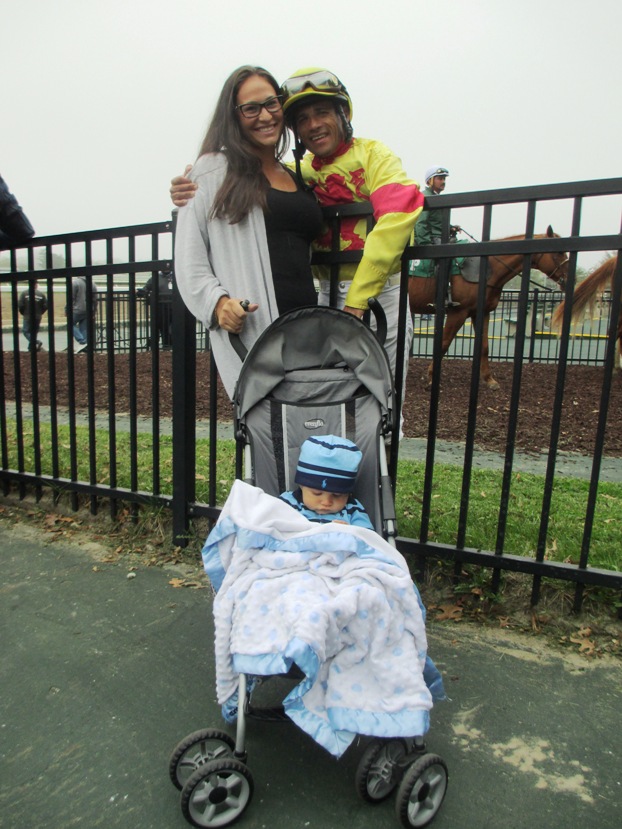
Celebrating a victory with the family.
While the job of riding fast horses is unquestionably as physically demanding as any athletic endeavor, the veteran Ferrer says that his profession does have one edge that keeps them going at it longer than most…that their results still depend on the abilities of the four-legged animal beneath them.
“Baseball player, 40 years old, you’re old. Football player, really old, because you’re depending on your body. But being a jockey, it’s 85% horse, so I’m thinking if I stay fit, I could ride wherever I want. If you’re still fit, you can do it for a long time.
“The challenge for riders when they get old is the weight, they don’t want to lose the weight and keep it down, and the older you get the heavier you get. Now that I’m a little bit older, I try to be in the best shape I can be. I lift a lot, I run a lot, and I do a lot of weights. I like to be strong.
“Why do players hit home runs? It’s a gift that God gave you. It’s about using that gift, some guys, they don’t use it.
“I’m proud of doing it for so long, staying consistent. You want to win big races, you want to win the Derby. But if you don’t have a chance, you move on. You keep doing what you’re doing. The man upstairs gave me a great family, a beautiful wife, that’s very important to me.”
And Ferrer already has career plans for his young son.
“I hope he’ll be a jockey or a baseball player. I love baseball.”

This jockey’s a pretty good bet.
The Ferrer Report
Jose Ferrer’s done alright at horse racing: 3,936 wins in 27,227 starts as of this writing (an average of almost a win in every seven starts), along with close to 7,000 place and show finishes as of this writing. His earnings over his 32-year career have totaled over $65 million, for an average of $2,400 per start.
He’s won a few big races, too: three Red Bank Stakes, two Miami Mile Breeder’s Cup Handicap races, the Iselin Handicap, the Jersey Shore Breeder’s Cup and the Matchmaker Stakes, to name a few. Ferrer is one of only five jockeys to have multiple Miami Mile wins, and is one of only three jockeys to have three or more Red Bank Stakes wins.
In 2015 thus far, Ferrer has 109 starts, and has already put 19 wins, 16 second place and 7 third place finishes on the board. His races have earned over $300,000 in winnings.

